-
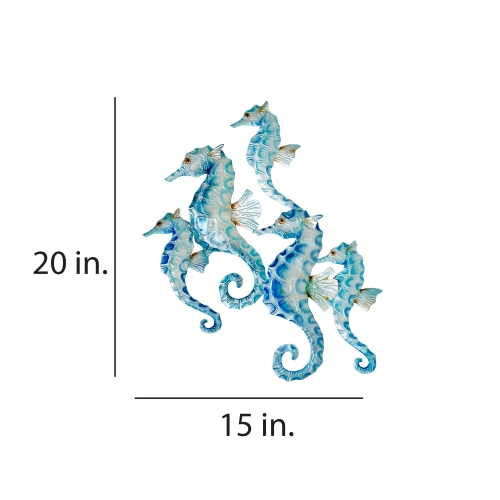
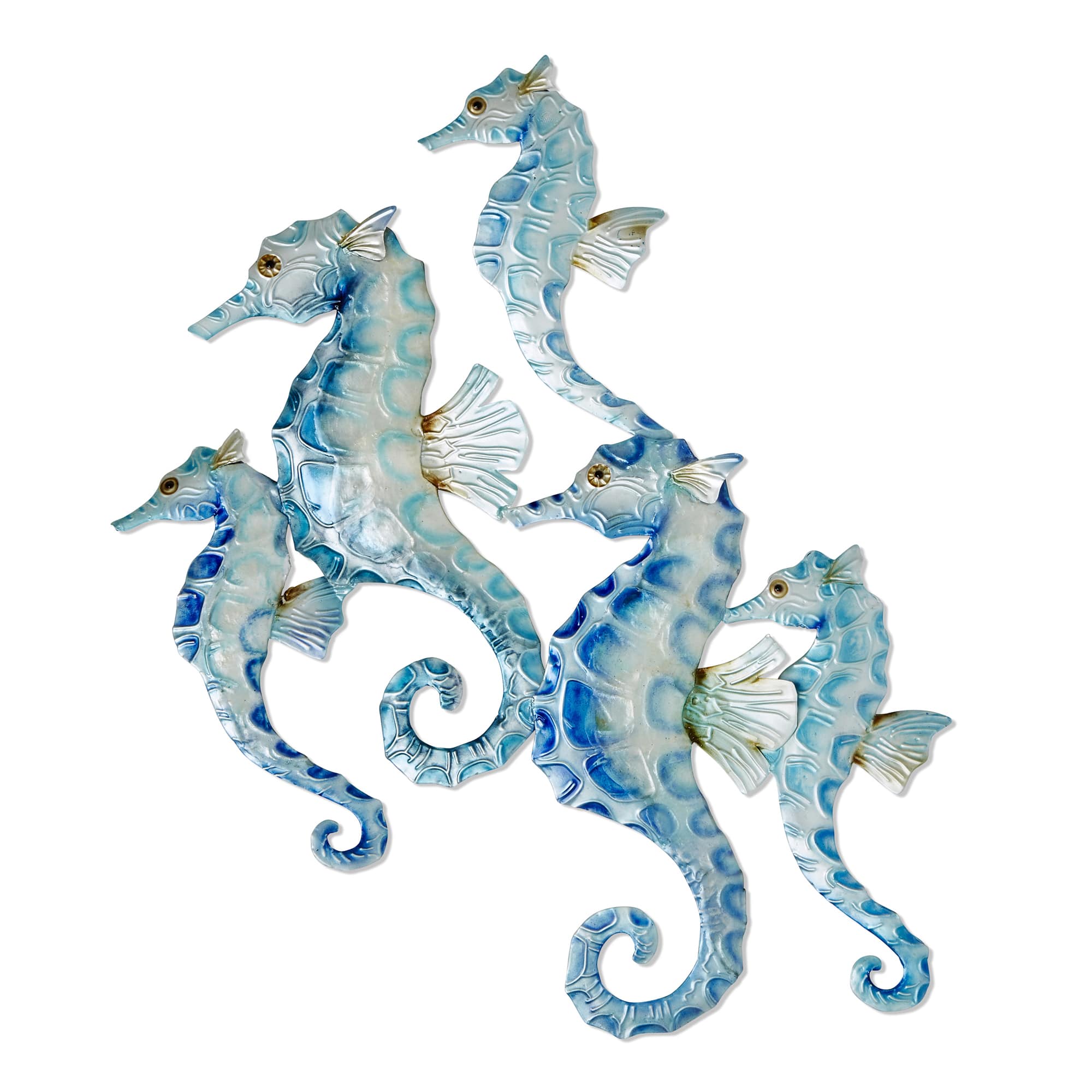 The seahorse has captured the minds and imaginations of people across all cultures for thousands of years. Seen as a symbol of good luck, strength and safety, this unique and beautiful animal is as charming as it is mysterious. The artist captures the beauty of the seahorse with a raised fine, high shine, hand-painted finish, and elegant mother of pearl on their chest and forefront. The basic frame of the wall seahorses is created using tin, which is powder coated as a black finish. Capiz is an oyster shell and the primary purpose of the oyster is as a source of food. However, the by-product, the shell, can be used for decoration. Due to it being a natural material, the natural colors of the capiz can come through as tans and browns.
The seahorse has captured the minds and imaginations of people across all cultures for thousands of years. Seen as a symbol of good luck, strength and safety, this unique and beautiful animal is as charming as it is mysterious. The artist captures the beauty of the seahorse with a raised fine, high shine, hand-painted finish, and elegant mother of pearl on their chest and forefront. The basic frame of the wall seahorses is created using tin, which is powder coated as a black finish. Capiz is an oyster shell and the primary purpose of the oyster is as a source of food. However, the by-product, the shell, can be used for decoration. Due to it being a natural material, the natural colors of the capiz can come through as tans and browns. -
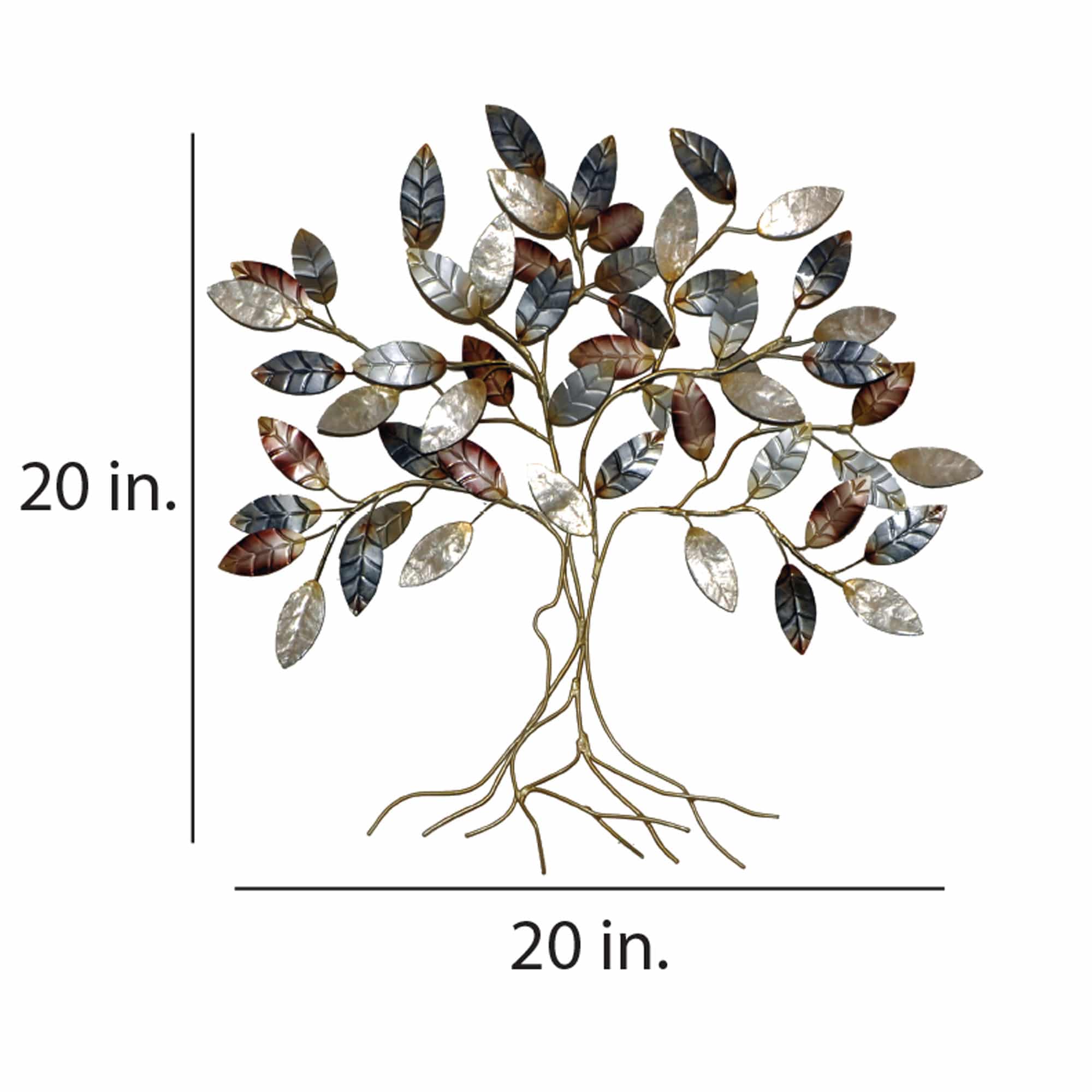
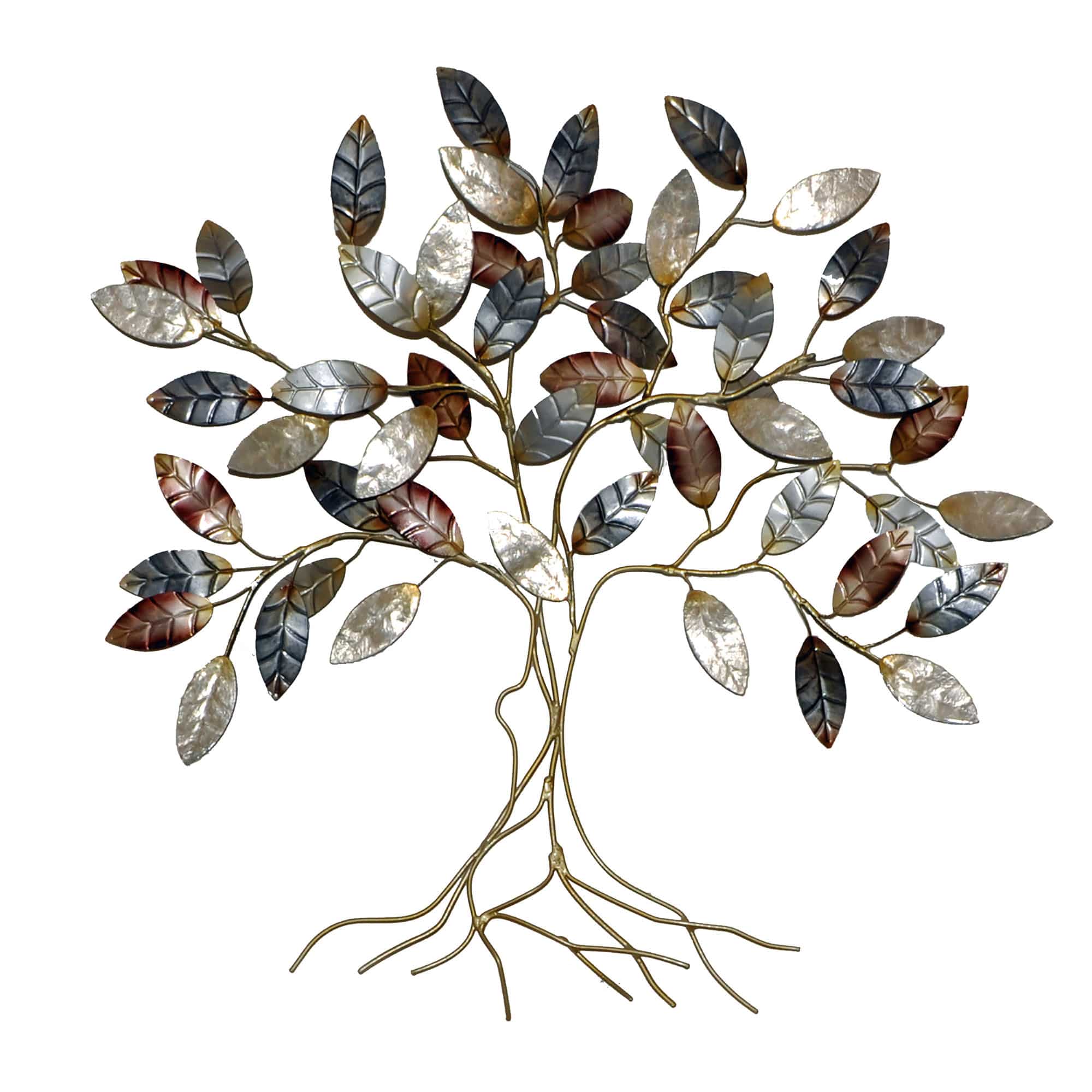 Trees have a special place in cultures around the world and through the ages. The definition of the beauty and utility of trees are clear, be it from the strong roots, the thick trunk, or the lush canopy. The artisan, in this case, used capiz to accentuate the bright leaves and used wired to stress the strength of the trunk and roots. Instead of using traditional colors, the artisan used a color palette that is unique but just as alluring and complementary. The basic frame of the framed of the tree is created using wrought iron, which is powder coated with a black finish. Capiz is an oyster shell and the primary purpose of the oyster is as a source of food. However, the by-product, the shell, can be used for decoration. Due to it being a natural material, the natural colors of the capiz come through as tans and browns underneath the paint. The shell is then painted the bold colors you see. The entire front facing piece is carefully hand-painted keeping in mind the reflective qualities in the color.
Trees have a special place in cultures around the world and through the ages. The definition of the beauty and utility of trees are clear, be it from the strong roots, the thick trunk, or the lush canopy. The artisan, in this case, used capiz to accentuate the bright leaves and used wired to stress the strength of the trunk and roots. Instead of using traditional colors, the artisan used a color palette that is unique but just as alluring and complementary. The basic frame of the framed of the tree is created using wrought iron, which is powder coated with a black finish. Capiz is an oyster shell and the primary purpose of the oyster is as a source of food. However, the by-product, the shell, can be used for decoration. Due to it being a natural material, the natural colors of the capiz come through as tans and browns underneath the paint. The shell is then painted the bold colors you see. The entire front facing piece is carefully hand-painted keeping in mind the reflective qualities in the color. -
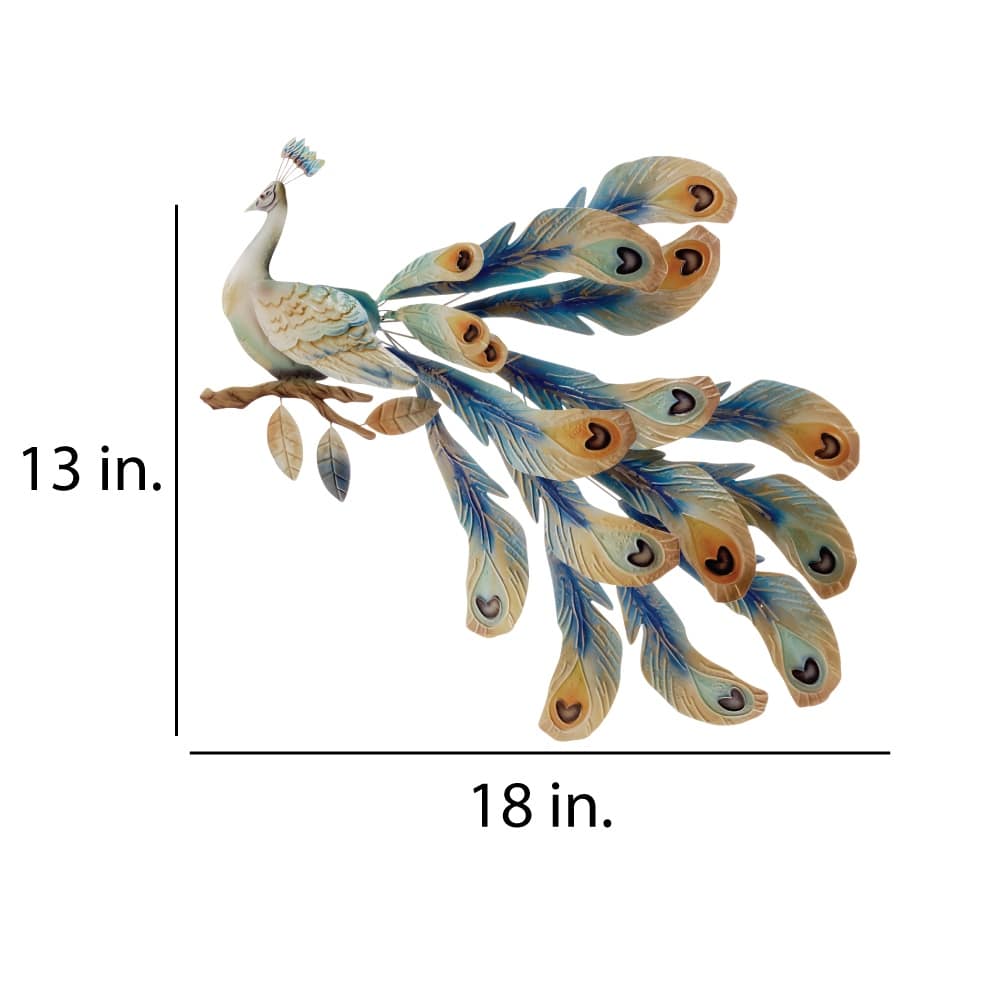
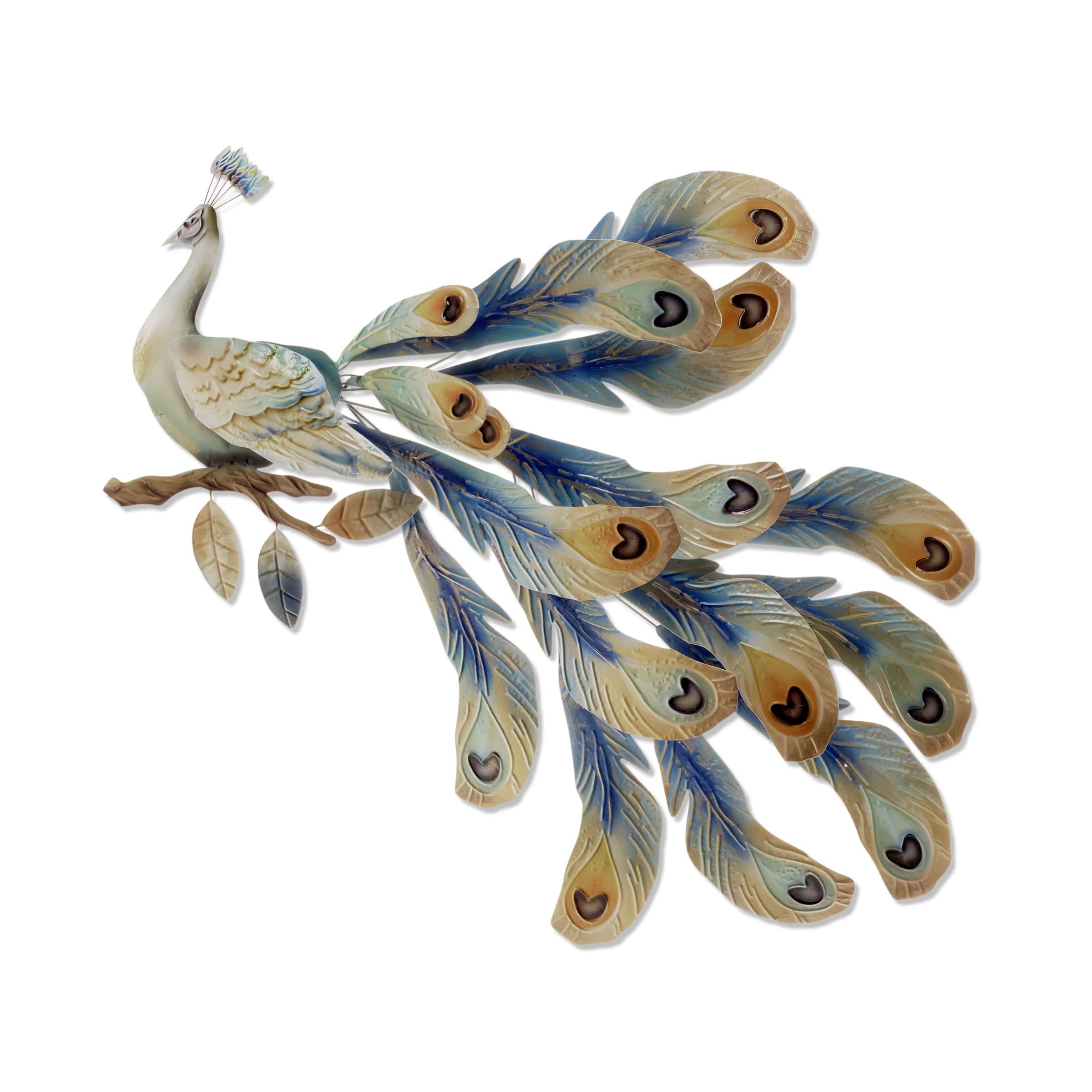 This elegant peacock is relaxed and calm, pluming through its feathers. Throughout its tail-feathers, the artists drew in the peacock's distinctive eyespots, with the eye itself in different colors. The chest of the bird is crafted from capiz shell, carefully painted in the blues and greens this bird is known for. It will fit perfectly within any decor style and add the finishing touch to its surroundings. The basic frame of the cat is created using tin, which is powder coated with a black finish. The frame is reinforced using tin wire along the inner edge. Capiz is an oyster shell and the primary purpose of the oyster is as a source of food. However, the by-product, the shell, can be used for decoration. Due to it being a natural material, the natural colors of the capiz come through as tans and browns underneath the paint. The shell is then painted the bold colors you see. The entire front facing piece is carefully hand-painted.
This elegant peacock is relaxed and calm, pluming through its feathers. Throughout its tail-feathers, the artists drew in the peacock's distinctive eyespots, with the eye itself in different colors. The chest of the bird is crafted from capiz shell, carefully painted in the blues and greens this bird is known for. It will fit perfectly within any decor style and add the finishing touch to its surroundings. The basic frame of the cat is created using tin, which is powder coated with a black finish. The frame is reinforced using tin wire along the inner edge. Capiz is an oyster shell and the primary purpose of the oyster is as a source of food. However, the by-product, the shell, can be used for decoration. Due to it being a natural material, the natural colors of the capiz come through as tans and browns underneath the paint. The shell is then painted the bold colors you see. The entire front facing piece is carefully hand-painted. -
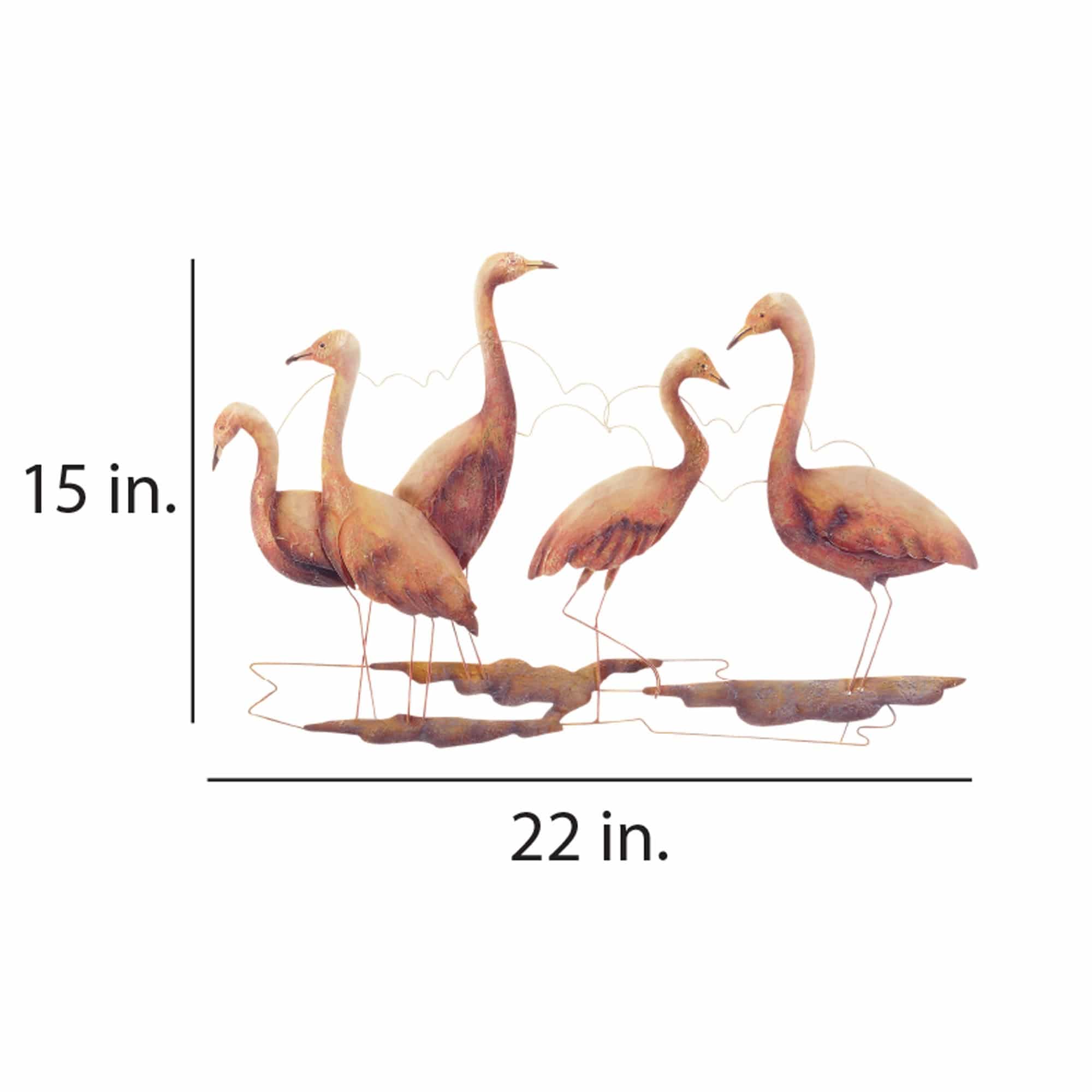
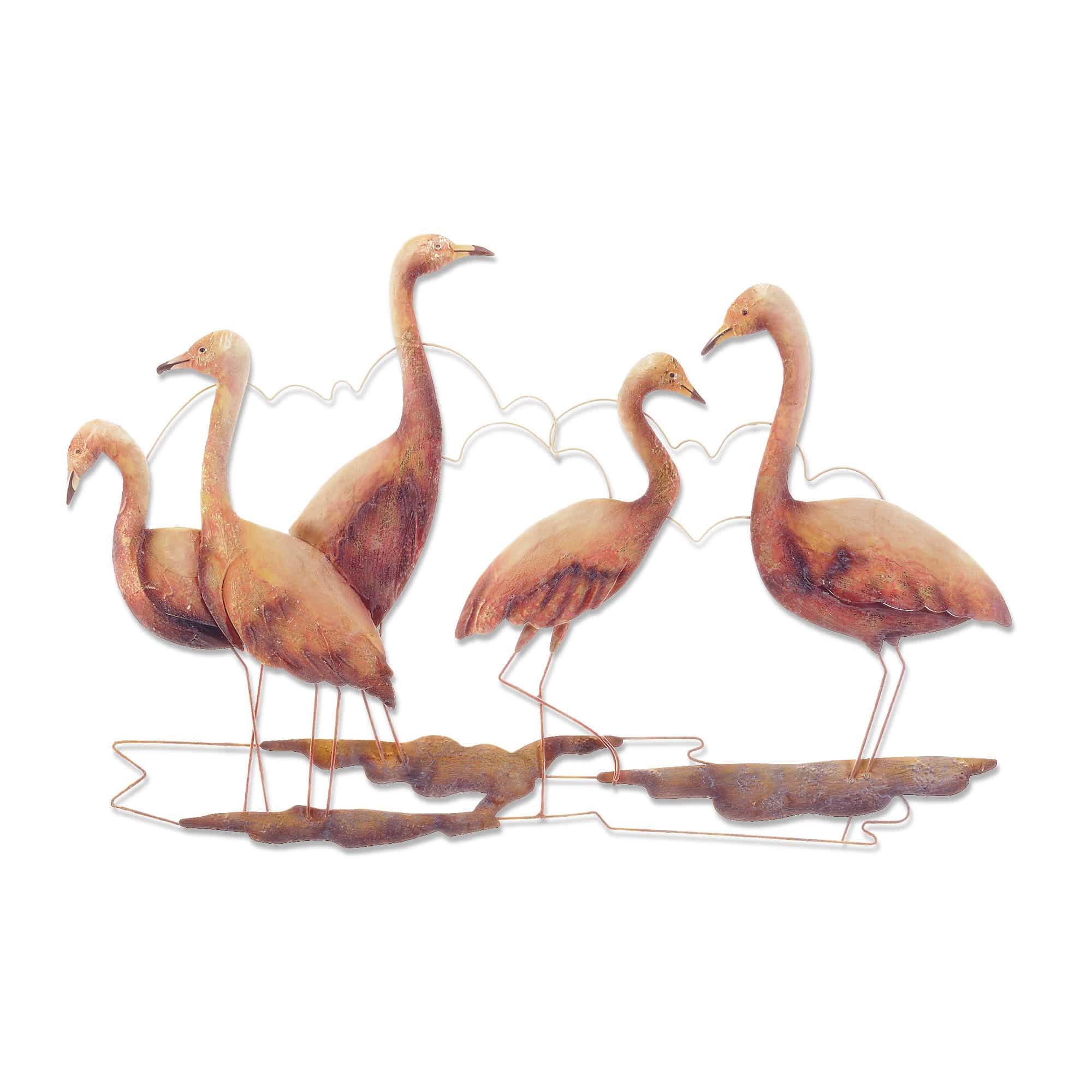 The name 'flamingo' comes from the Portuguese or Spanish 'flamengo,' which means 'flame-colored.' Born gray in hues, flamingos get their flamboyant color from brine shrimp that make up most of their diet. Flamingos are very social animals and the artist depicts this by creating a group of five birds wading through the calm water enjoying a warm day. The artist takes time in pressing the metal creating texture in the wings and body, and also uses metallic paints to highlight the famous colors of one of the most recognizable birds on the planet. The basic frame of this piece is created using tin, which is powder coated with a black finish. The frame is reinforced using tin wire along the inner edge. The front of the body is adorned with capiz. Capiz is an oyster shell and the primary purpose of the oyster is as a source of food. However, the by-product, the shell, can be used for decoration. Due to it being a natural material, the natural colors of the capiz may come through as tans and browns underneath the hand-painted surface.
The name 'flamingo' comes from the Portuguese or Spanish 'flamengo,' which means 'flame-colored.' Born gray in hues, flamingos get their flamboyant color from brine shrimp that make up most of their diet. Flamingos are very social animals and the artist depicts this by creating a group of five birds wading through the calm water enjoying a warm day. The artist takes time in pressing the metal creating texture in the wings and body, and also uses metallic paints to highlight the famous colors of one of the most recognizable birds on the planet. The basic frame of this piece is created using tin, which is powder coated with a black finish. The frame is reinforced using tin wire along the inner edge. The front of the body is adorned with capiz. Capiz is an oyster shell and the primary purpose of the oyster is as a source of food. However, the by-product, the shell, can be used for decoration. Due to it being a natural material, the natural colors of the capiz may come through as tans and browns underneath the hand-painted surface. -


Classically painted roses adorn this set of three butterflies. The traditional pattern brings the garden indoors. Painted on mother of pearl oyster shells, the vibrant roses pop, adding color and charm.
The basic frame of the butterfly is created using tin, which is powder-coated with a black finish and makes this piece safe to use outdoors. The edges of the frame are reinforced using thicker tin wire. The front of this piece is adorned in areas with capiz shell, an oyster native to the Philippines, before being hand-painted and sealed with a water-based sealant. The primary purpose of this oyster to provide a source of food, however, the shell is a sustainable by-product that can be used for decoration. The capiz shell subtly replicates the reflective qualities of butterflies in nature. The entire piece is lightweight and has an eyelet in the back allowing it to be hung using a finishing nail, command strip, or a push pin. Due to it being a natural material, the organic colors of capiz come through as tans and browns underneath the paint.
-
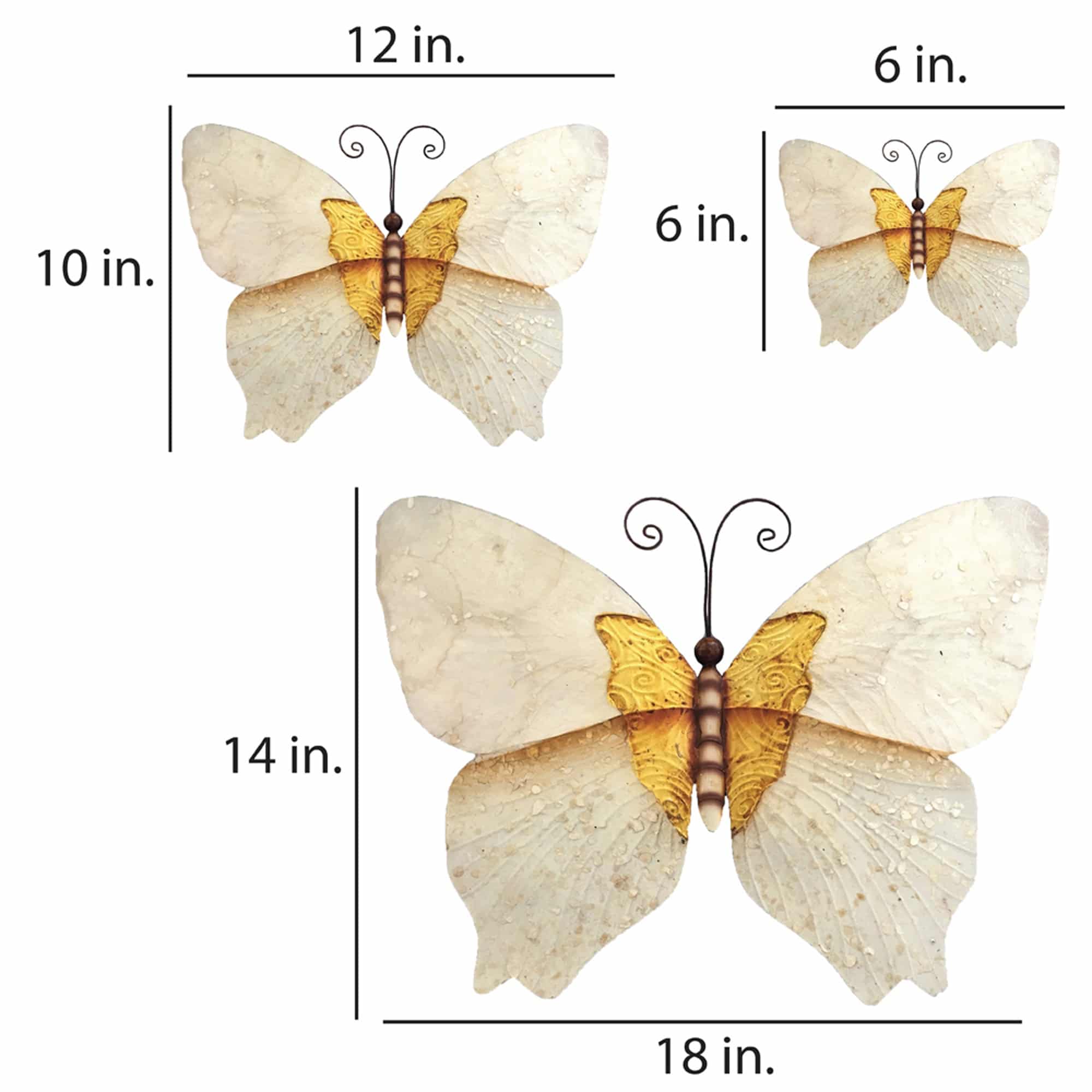

The set of three butterflies are influenced by the midcentury color pallet. The upper wings are adorned with capiz shell, giving it the translucent color seen in the natural butterfly. The lower wings are constructed from tin, textured, to accentuate the veins of the butterfly. Highlighted at the center is a burst of gold which trickles down to the lower portion of the wings.
The basic frame of the butterfly is created using tin, which is powder-coated with a black finish and makes this piece safe to use outdoors. The edges of the frame are reinforced using thicker tin wire. The front of this piece is adorned in areas with capiz shell, an oyster native to the Philippines, before being hand-painted and sealed with a water-based sealant. The primary purpose of this oyster to provide a source of food, however, the shell is a sustainable by-product that can be used for decoration. The capiz shell subtly replicates the reflective qualities of butterflies in nature. The entire piece is lightweight and has an eyelet in the back allowing it to be hung using a finishing nail, command strip, or a push pin. Due to it being a natural material, the organic colors of capiz come through as tans and browns underneath the paint.
-

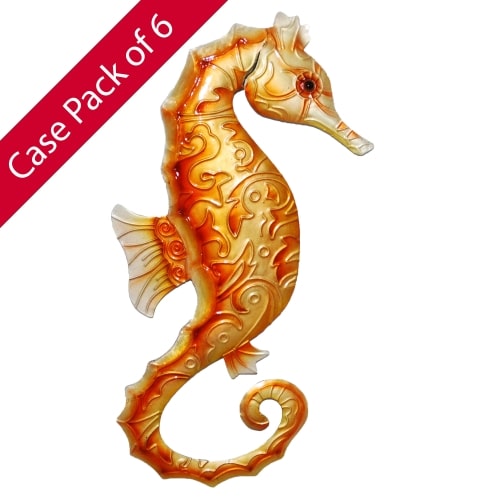 Case of 6 The seahorse has captured the minds and imaginations of people across all cultures for thousands of years. Seen as a symbol of good luck, strength and safety, this unique and beautiful animal is as charming as it is mysterious. The artist captures the beauty of the seahorse with a raised fine, high shine, hand-painted finish, and elegant mother of pearl chest and forefront. The basic frame of the wall seahorse is created using tin, which is powder coated as a black finish. Capiz is an oyster shell and the primary purpose of the oyster is as a source of food. However, the by-product, the shell, can be used for decoration. Due to it being a natural material, the natural colors of the capiz can come through as tans and browns.
Case of 6 The seahorse has captured the minds and imaginations of people across all cultures for thousands of years. Seen as a symbol of good luck, strength and safety, this unique and beautiful animal is as charming as it is mysterious. The artist captures the beauty of the seahorse with a raised fine, high shine, hand-painted finish, and elegant mother of pearl chest and forefront. The basic frame of the wall seahorse is created using tin, which is powder coated as a black finish. Capiz is an oyster shell and the primary purpose of the oyster is as a source of food. However, the by-product, the shell, can be used for decoration. Due to it being a natural material, the natural colors of the capiz can come through as tans and browns. -
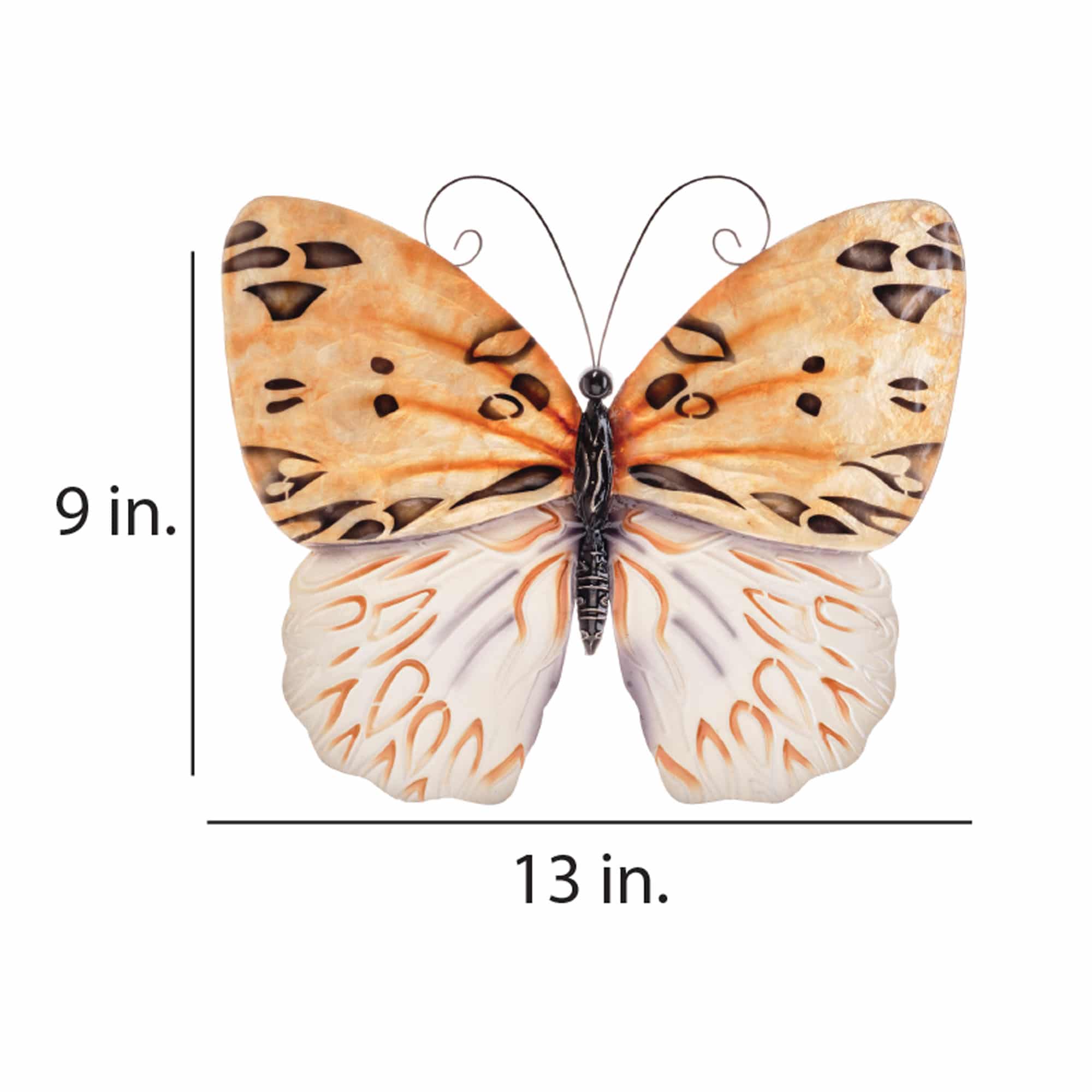
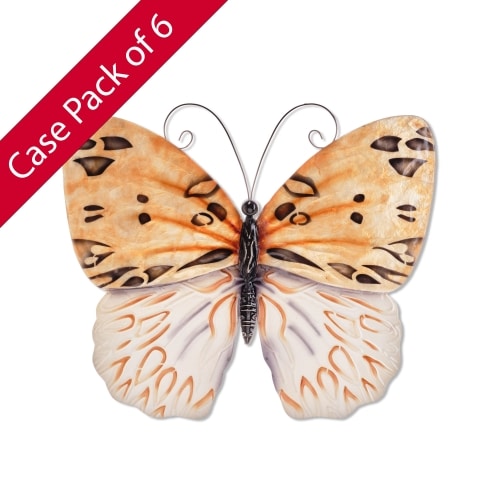 Case of 6
Case of 6Using paints of various shades and different hues of yellow, this graceful butterfly features an appearance of flowing honey on its upper wings. The lower wings diverge from the honey and are textured in a base white color with highlights of yellow. Stylish and elegant, this piece adds sophistication to the finish of any room, contemporary or traditional.
The basic frame of the butterfly is created using tin, which is powder-coated with a black finish and makes this piece safe to use outdoors. The edges of the frame are reinforced using thicker tin wire. The front of this piece is adorned in areas with capiz shell, an oyster native to the Philippines, before being hand-painted and sealed with a water-based sealant. The primary purpose of this oyster to provide a source of food, however, the shell is a sustainable by-product that can be used for decoration. The capiz shell subtly replicates the reflective qualities of butterflies in nature. The entire piece is lightweight and has an eyelet in the back allowing it to be hung using a finishing nail, command strip, or a push pin. Due to it being a natural material, the organic colors of capiz come through as tans and browns underneath the paint.
-
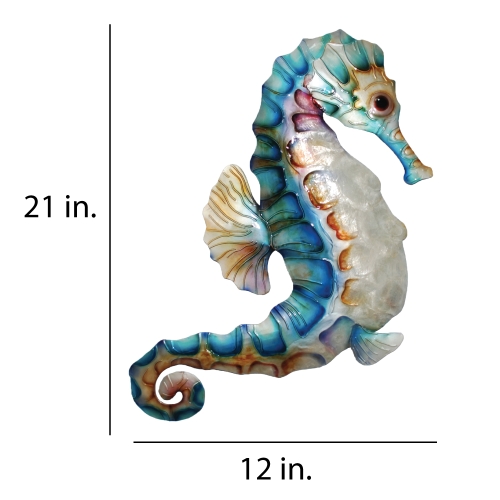
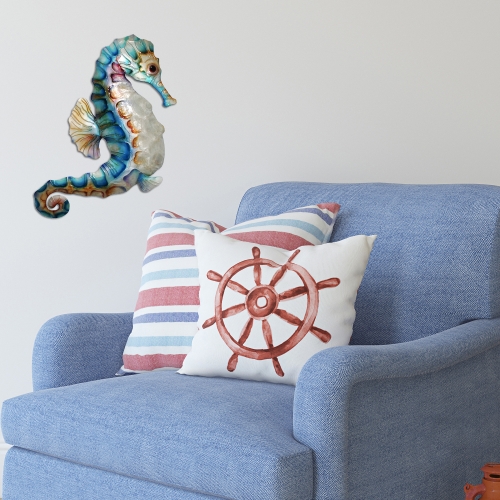 The Seahorse Wall Décor is a beautiful and unique addition to any home. The seahorse symbolizes discovery of balance in life and transformation of energy into positive thoughts. And because of the way seahorses move, they're also symbolic of peace and patience. The artist captures the splendor of the seahorse with a raised fin, high shine hand-painted finish, and capiz oyster shell chest and forefront. The Seahorse Wall Décor is the perfect way to bring good luck, strength, and beauty into your home. The basic frame of the Seahorse is created using tin, which is powder-coated with a black finish and makes this piece safe to use outdoors. The edges of the frame are reinforced using thicker tin wire. The front of this piece is adorned in areas with capiz shell, an oyster native to the Philippines, before being hand-painted and sealed with a water-based sealant. The primary purpose of this oyster to provide a source of food, however, the shell is a sustainable by-product that can be used for decoration. The capiz shell subtly replicates the reflective qualities of seahorses in nature. The entire piece is lightweight and has an eyelet in the back allowing it to be hung using a finishing nail, command strip, or a push pin. Due to it being a natural material, the organic colors of capiz come through as tans and browns underneath the paint.
The Seahorse Wall Décor is a beautiful and unique addition to any home. The seahorse symbolizes discovery of balance in life and transformation of energy into positive thoughts. And because of the way seahorses move, they're also symbolic of peace and patience. The artist captures the splendor of the seahorse with a raised fin, high shine hand-painted finish, and capiz oyster shell chest and forefront. The Seahorse Wall Décor is the perfect way to bring good luck, strength, and beauty into your home. The basic frame of the Seahorse is created using tin, which is powder-coated with a black finish and makes this piece safe to use outdoors. The edges of the frame are reinforced using thicker tin wire. The front of this piece is adorned in areas with capiz shell, an oyster native to the Philippines, before being hand-painted and sealed with a water-based sealant. The primary purpose of this oyster to provide a source of food, however, the shell is a sustainable by-product that can be used for decoration. The capiz shell subtly replicates the reflective qualities of seahorses in nature. The entire piece is lightweight and has an eyelet in the back allowing it to be hung using a finishing nail, command strip, or a push pin. Due to it being a natural material, the organic colors of capiz come through as tans and browns underneath the paint. -
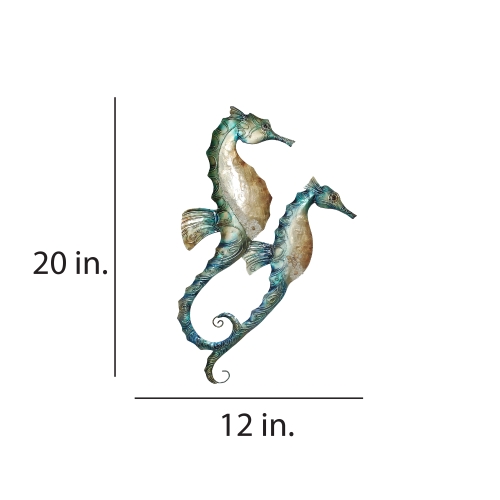
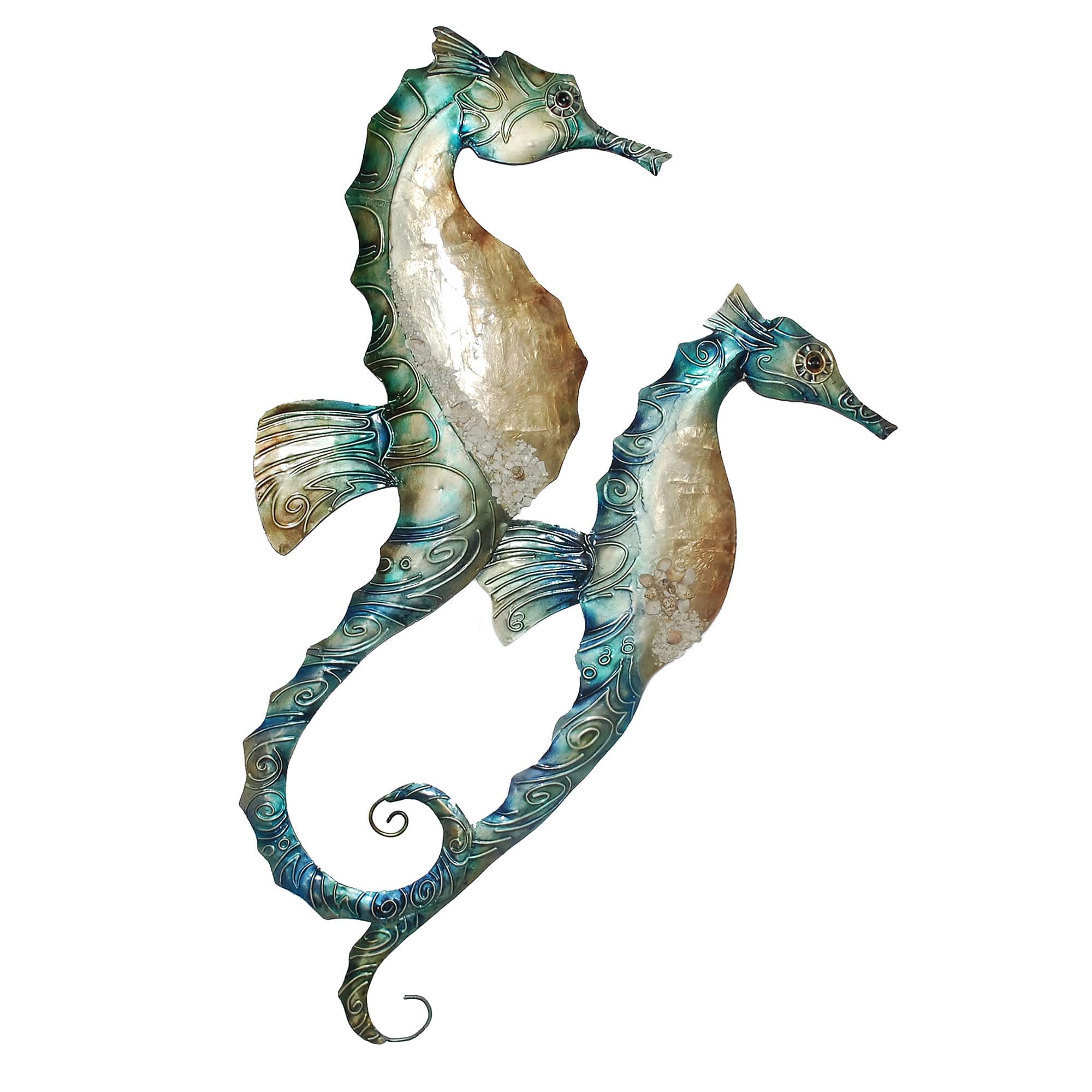 The seahorse has captured the minds and imaginations of people across all cultures for thousands of years. Seen as a symbol of good luck, strength and safety, this unique and beautiful animal is as charming as it is mysterious. The artist captures the beauty of the seahorse with a raised fine, high shine, hand-painted finish, and elegant mother of pearl on their chest and forefront. The basic frame of the wall seahorses is created using tin, which is powder coated as a black finish. Capiz is an oyster shell and the primary purpose of the oyster is as a source of food. However, the by-product, the shell, can be used for decoration. Due to it being a natural material, the natural colors of the capiz can come through as tans and browns.
The seahorse has captured the minds and imaginations of people across all cultures for thousands of years. Seen as a symbol of good luck, strength and safety, this unique and beautiful animal is as charming as it is mysterious. The artist captures the beauty of the seahorse with a raised fine, high shine, hand-painted finish, and elegant mother of pearl on their chest and forefront. The basic frame of the wall seahorses is created using tin, which is powder coated as a black finish. Capiz is an oyster shell and the primary purpose of the oyster is as a source of food. However, the by-product, the shell, can be used for decoration. Due to it being a natural material, the natural colors of the capiz can come through as tans and browns. -
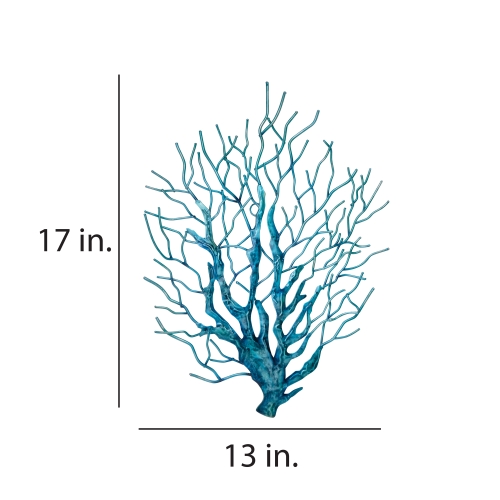
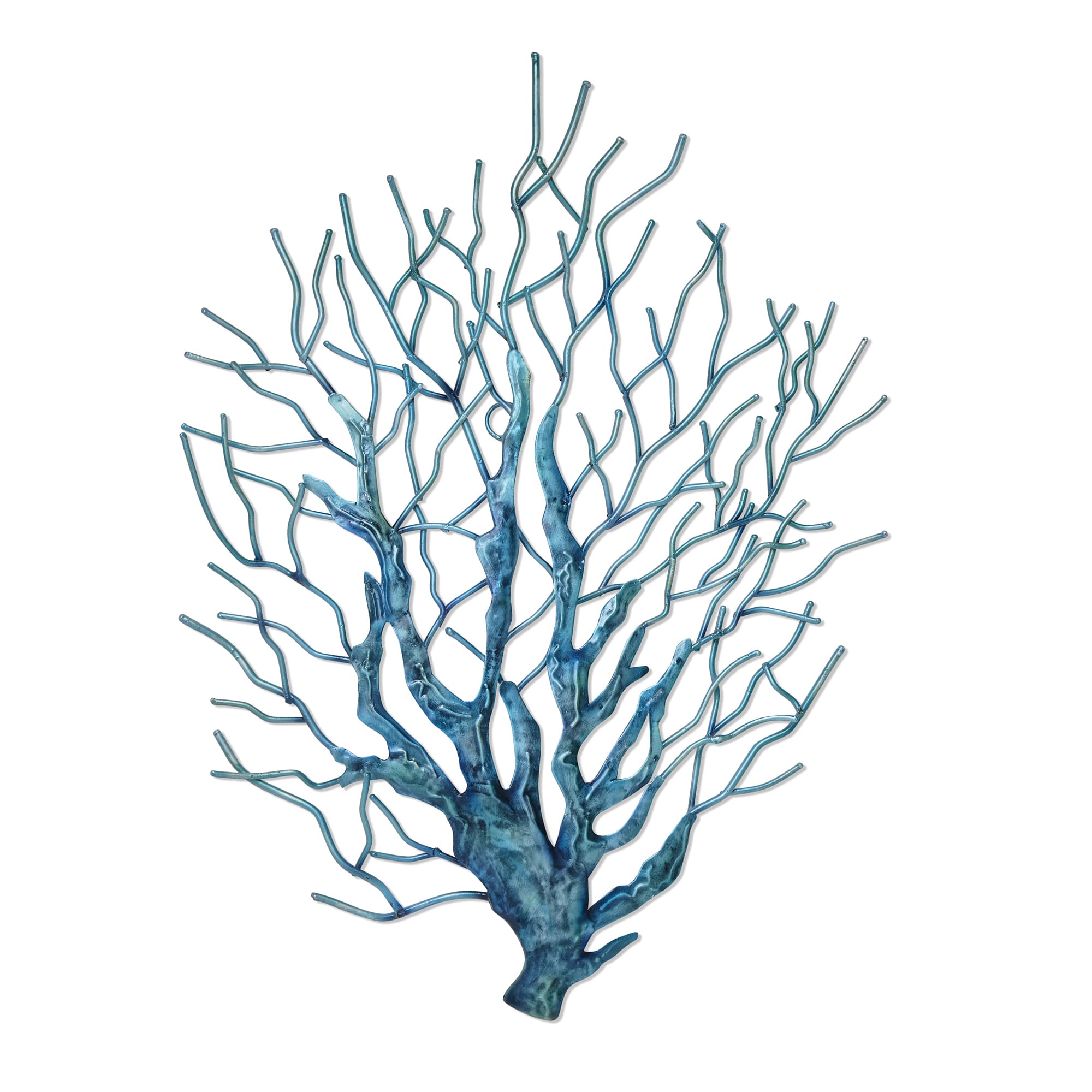 This piece features ten schooling mackerels swimming calmly with fins raised as if catching an ocean current. In their largest numbers, mackerels have been found to travel in schools that stretch as far as 20 miles. Painted by hand the artist uses aqua tones reminiscent of its ocean habitat. Capiz oyster shell adorn the front adding a watery shimmer. The basic frame of this piece is created using tin, which is powder coated with a black finish. The frame is reinforced using tin wire along the inner edge. The front of the body is adorned with capiz. Capiz is an oyster shell and the primary purpose of the oyster is as a source of food. However, the by-product, the shell, can be used for decoration. Due to it being a natural material, the natural colors of the capiz may come through as tans and browns underneath the hand-painted surface.
This piece features ten schooling mackerels swimming calmly with fins raised as if catching an ocean current. In their largest numbers, mackerels have been found to travel in schools that stretch as far as 20 miles. Painted by hand the artist uses aqua tones reminiscent of its ocean habitat. Capiz oyster shell adorn the front adding a watery shimmer. The basic frame of this piece is created using tin, which is powder coated with a black finish. The frame is reinforced using tin wire along the inner edge. The front of the body is adorned with capiz. Capiz is an oyster shell and the primary purpose of the oyster is as a source of food. However, the by-product, the shell, can be used for decoration. Due to it being a natural material, the natural colors of the capiz may come through as tans and browns underneath the hand-painted surface. -
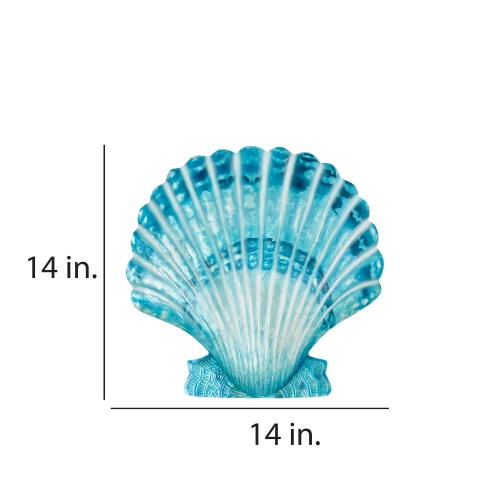
 The design is based on the shape of the Senatorial scallop found in the tropical waters of the pacific. Like the rings of a tree, one can determine the age of a scallop my counting the rings on its shell. Each ring represents one year of growth. The artist using this feature to add beautiful detail along with a deep aqua color to reflect its ocean habitat. Real capiz oyster shell adorns the exterior giving this piece a shimmer as if light were bouncing off its shell from under water. The basic frame of this piece is created using tin, which is powder coated with a black finish. The frame is reinforced using tin wire along the inner edge. The front of the body is adorned with capiz. Capiz is an oyster shell and the primary purpose of the oyster is as a source of food. However, the by-product, the shell, can be used for decoration. Due to it being a natural material, the natural colors of the capiz may come through as tans and browns underneath the hand-painted surface.
The design is based on the shape of the Senatorial scallop found in the tropical waters of the pacific. Like the rings of a tree, one can determine the age of a scallop my counting the rings on its shell. Each ring represents one year of growth. The artist using this feature to add beautiful detail along with a deep aqua color to reflect its ocean habitat. Real capiz oyster shell adorns the exterior giving this piece a shimmer as if light were bouncing off its shell from under water. The basic frame of this piece is created using tin, which is powder coated with a black finish. The frame is reinforced using tin wire along the inner edge. The front of the body is adorned with capiz. Capiz is an oyster shell and the primary purpose of the oyster is as a source of food. However, the by-product, the shell, can be used for decoration. Due to it being a natural material, the natural colors of the capiz may come through as tans and browns underneath the hand-painted surface. -
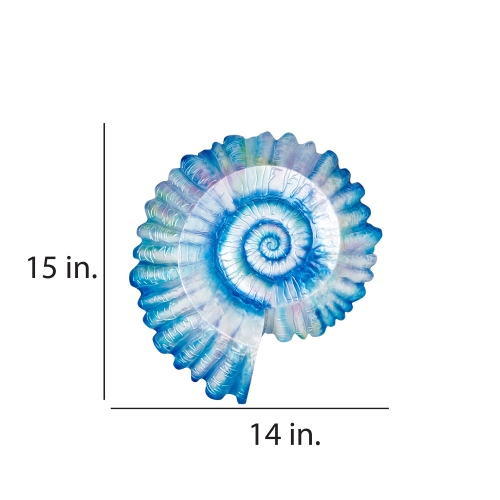
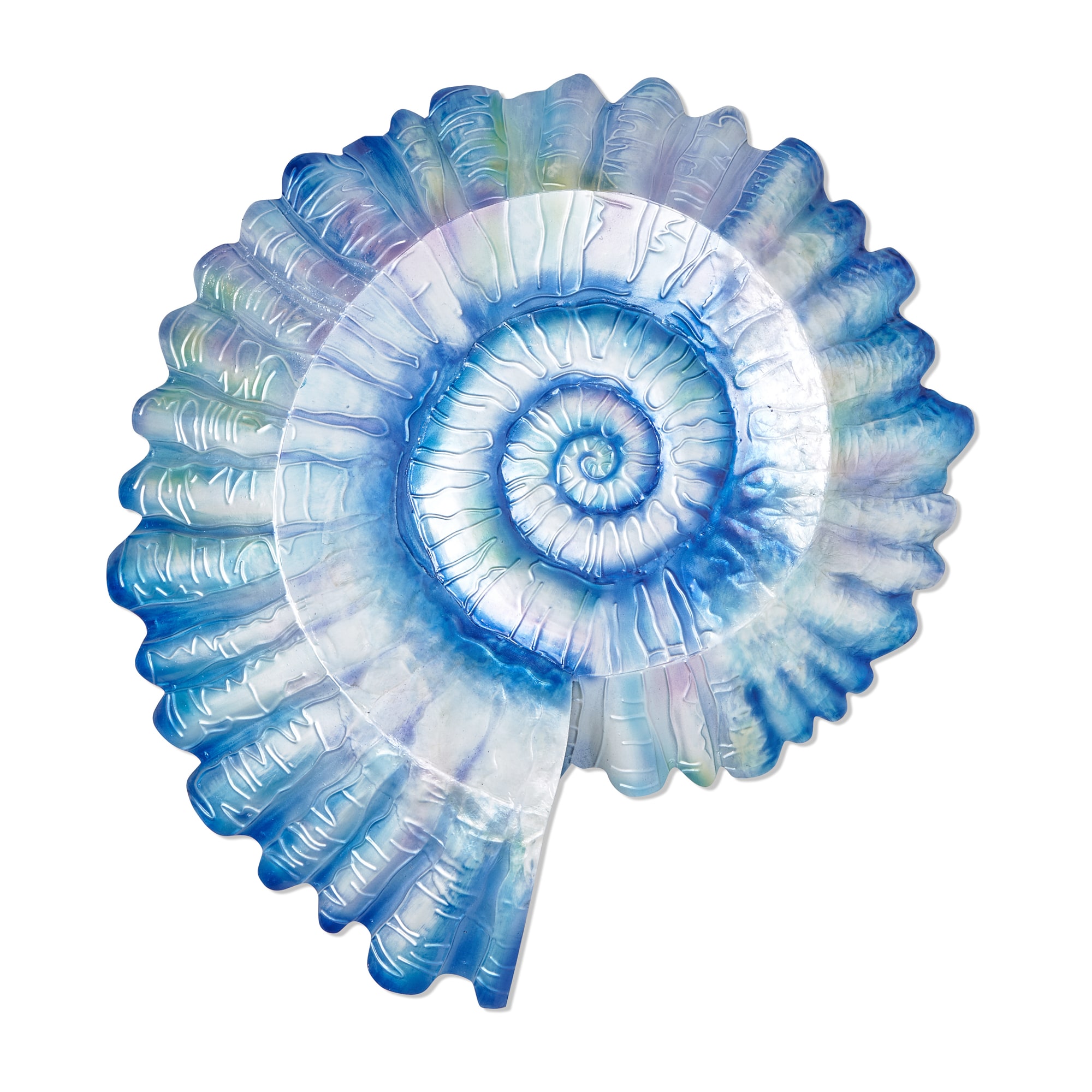 The spiral, flat seashell shape is a familiar one, but few know what actually live inside. This shell belongs to a creature known as a nautilus. Related to octopus, this creature is mobile, able to jettison itself through the ocean with streams of water. The artist captures its classic shape and adds deep shades of sea blue. Capiz oyster shell adorns its exterior as if it were glistening under water. The basic frame of this piece is created using tin, which is powder coated with a black finish. The frame is reinforced using tin wire along the inner edge. The front of the body is adorned with capiz. Capiz is an oyster shell and the primary purpose of the oyster is as a source of food. However, the by-product, the shell, can be used for decoration. Due to it being a natural material, the natural colors of the capiz may come through as tans and browns underneath the hand-painted surface.
The spiral, flat seashell shape is a familiar one, but few know what actually live inside. This shell belongs to a creature known as a nautilus. Related to octopus, this creature is mobile, able to jettison itself through the ocean with streams of water. The artist captures its classic shape and adds deep shades of sea blue. Capiz oyster shell adorns its exterior as if it were glistening under water. The basic frame of this piece is created using tin, which is powder coated with a black finish. The frame is reinforced using tin wire along the inner edge. The front of the body is adorned with capiz. Capiz is an oyster shell and the primary purpose of the oyster is as a source of food. However, the by-product, the shell, can be used for decoration. Due to it being a natural material, the natural colors of the capiz may come through as tans and browns underneath the hand-painted surface. -
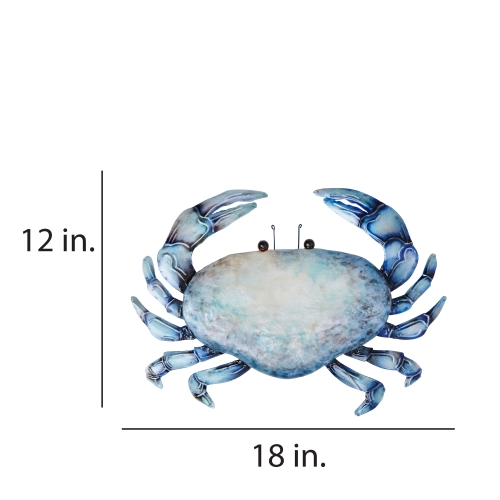
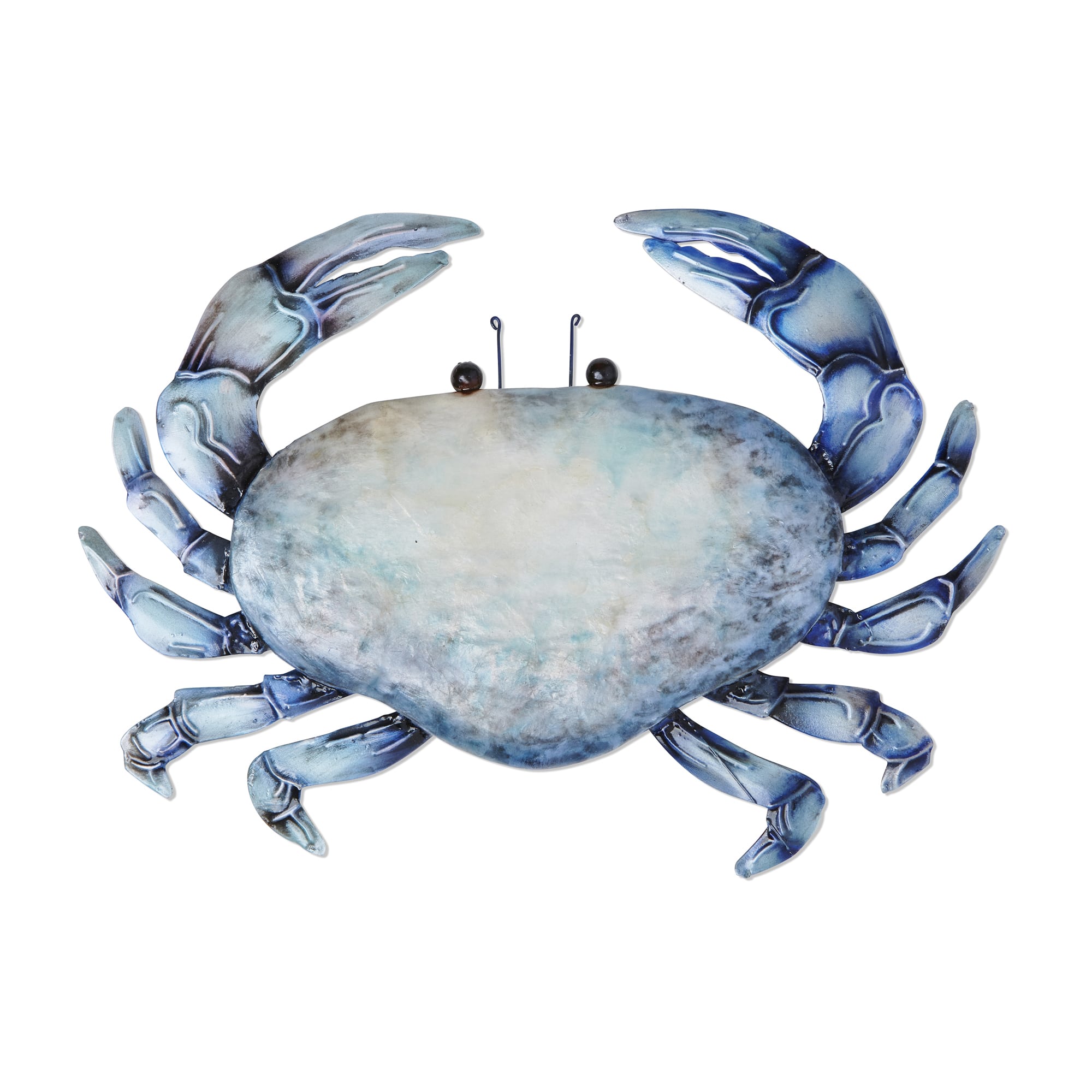 The frame of the piece is an Emerald Crab, which are commonly found in tropical waters of the Caribbean Sea. The maritime blue colors reflect the waters of its natural habitat while exhibiting calm and cool colors. The artist also creates slight contrasts between the body of the crab using capiz oyster shells and the matted outer legs and pinchers. The body will reflect light making it seem bolder. The basic frame of this piece is created using tin, which is powder coated with a black finish. The frame is reinforced using tin wire along the inner edge. The front of the body is adorned with capiz. Capiz is an oyster shell and the primary purpose of the oyster is as a source of food. However, the by-product, the shell, can be used for decoration. Due to it being a natural material, the natural colors of the capiz may come through as tans and browns underneath the hand-painted surface.
The frame of the piece is an Emerald Crab, which are commonly found in tropical waters of the Caribbean Sea. The maritime blue colors reflect the waters of its natural habitat while exhibiting calm and cool colors. The artist also creates slight contrasts between the body of the crab using capiz oyster shells and the matted outer legs and pinchers. The body will reflect light making it seem bolder. The basic frame of this piece is created using tin, which is powder coated with a black finish. The frame is reinforced using tin wire along the inner edge. The front of the body is adorned with capiz. Capiz is an oyster shell and the primary purpose of the oyster is as a source of food. However, the by-product, the shell, can be used for decoration. Due to it being a natural material, the natural colors of the capiz may come through as tans and browns underneath the hand-painted surface. -
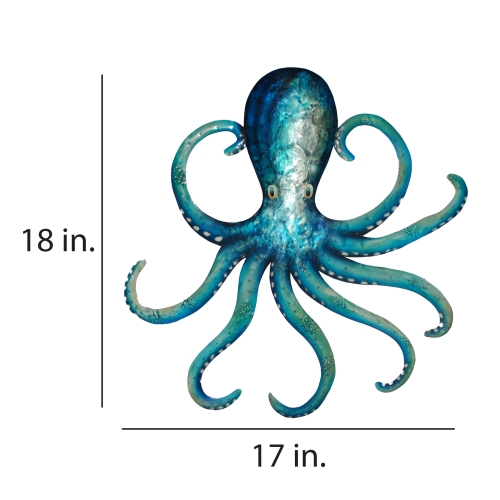
 The octopus has become known for its intelligence and curious nature. No other animal outside of birds and mammals has as large of a brain compared to the size its body as does the octopus. With eyes wide open, the artist reflects the inquisitive nature of this sea creature. Tones of blue represent its aquatic habitat. The use of capiz oyster shell bounces light from the front of this piece as if its reflecting light under water. The basic frame of this piece is created using tin, which is powder coated with a black finish. The frame is reinforced using tin wire along the inner edge. The front of the body is adorned with capiz. Capiz is an oyster shell and the primary purpose of the oyster is as a source of food. However, the by-product, the shell, can be used for decoration. Due to it being a natural material, the natural colors of the capiz may come through as tans and browns underneath the hand-painted surface.
The octopus has become known for its intelligence and curious nature. No other animal outside of birds and mammals has as large of a brain compared to the size its body as does the octopus. With eyes wide open, the artist reflects the inquisitive nature of this sea creature. Tones of blue represent its aquatic habitat. The use of capiz oyster shell bounces light from the front of this piece as if its reflecting light under water. The basic frame of this piece is created using tin, which is powder coated with a black finish. The frame is reinforced using tin wire along the inner edge. The front of the body is adorned with capiz. Capiz is an oyster shell and the primary purpose of the oyster is as a source of food. However, the by-product, the shell, can be used for decoration. Due to it being a natural material, the natural colors of the capiz may come through as tans and browns underneath the hand-painted surface. -
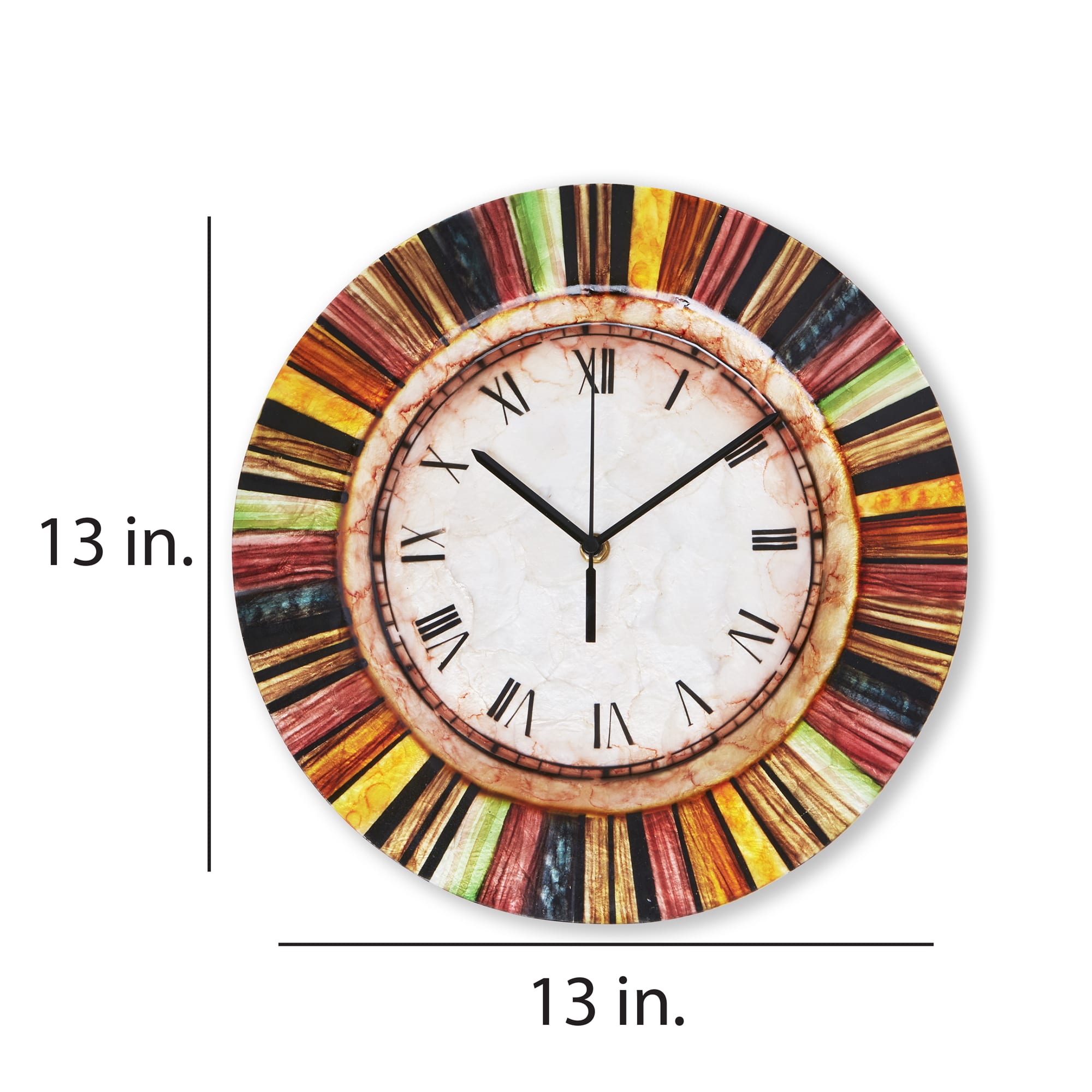
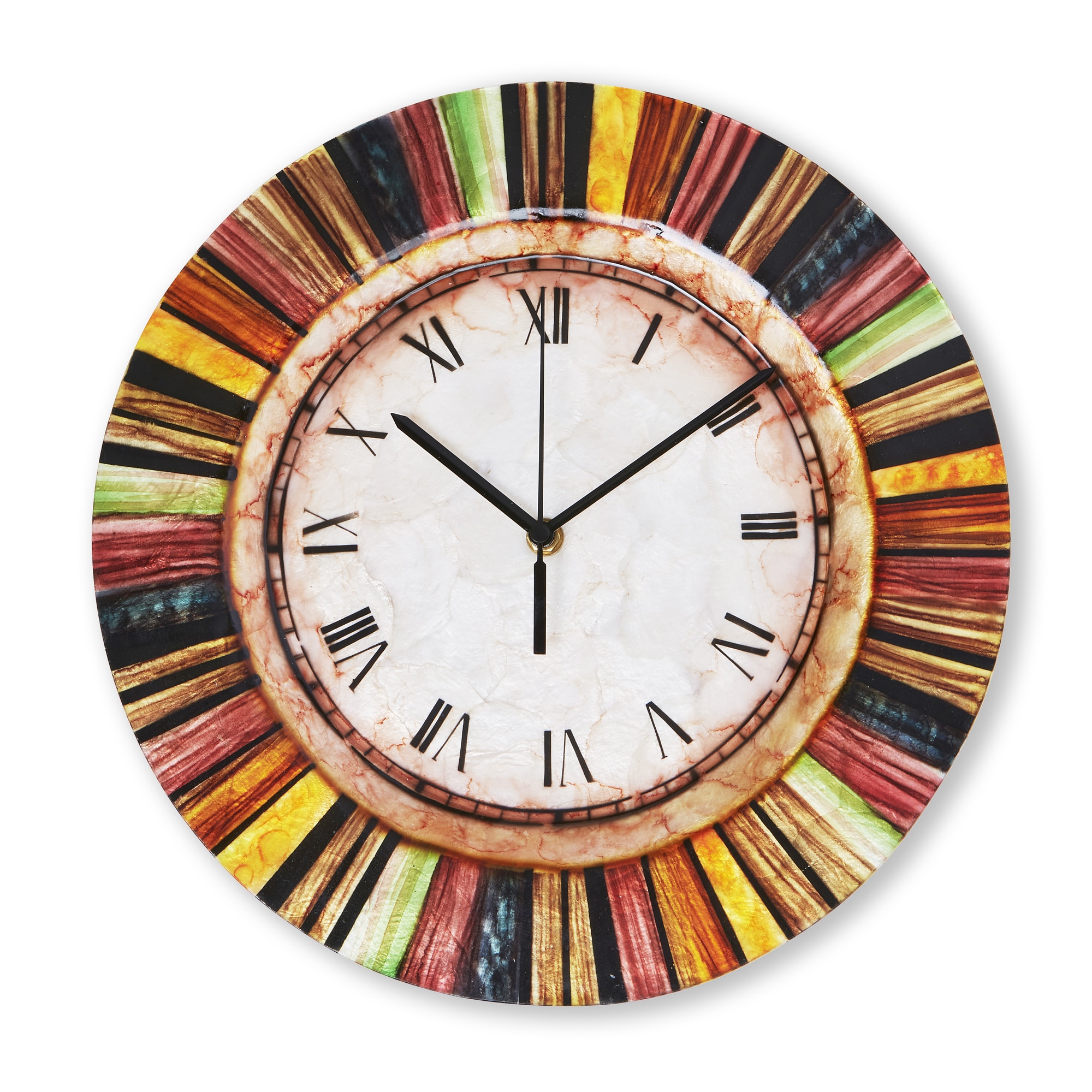 The frame of this clock is made with solid capiz oyster shell, compressed into shape.The artist calls attention to the uniqueness of each shell in the center with a high-gloss finish. Bold, roman numerals stand in contrast to the shell within the clock face. Color blocks adorn the outer rim of the clock in muted tones. The roman numerals combined with the color palette are strongly influenced from Tuscan design. Capiz is an oyster shell and the primary purpose of the oyster is as a source of food. However, the by-product, the shell, can be used for decoration. The clock is created by compressing capiz shell together and forming it into shape. The final result is a light-weight, plate that feels similar to plastic. Due to it being a natural material, the natural colors of the capiz may come through as tans and browns underneath the hand-painted surface.
The frame of this clock is made with solid capiz oyster shell, compressed into shape.The artist calls attention to the uniqueness of each shell in the center with a high-gloss finish. Bold, roman numerals stand in contrast to the shell within the clock face. Color blocks adorn the outer rim of the clock in muted tones. The roman numerals combined with the color palette are strongly influenced from Tuscan design. Capiz is an oyster shell and the primary purpose of the oyster is as a source of food. However, the by-product, the shell, can be used for decoration. The clock is created by compressing capiz shell together and forming it into shape. The final result is a light-weight, plate that feels similar to plastic. Due to it being a natural material, the natural colors of the capiz may come through as tans and browns underneath the hand-painted surface. -

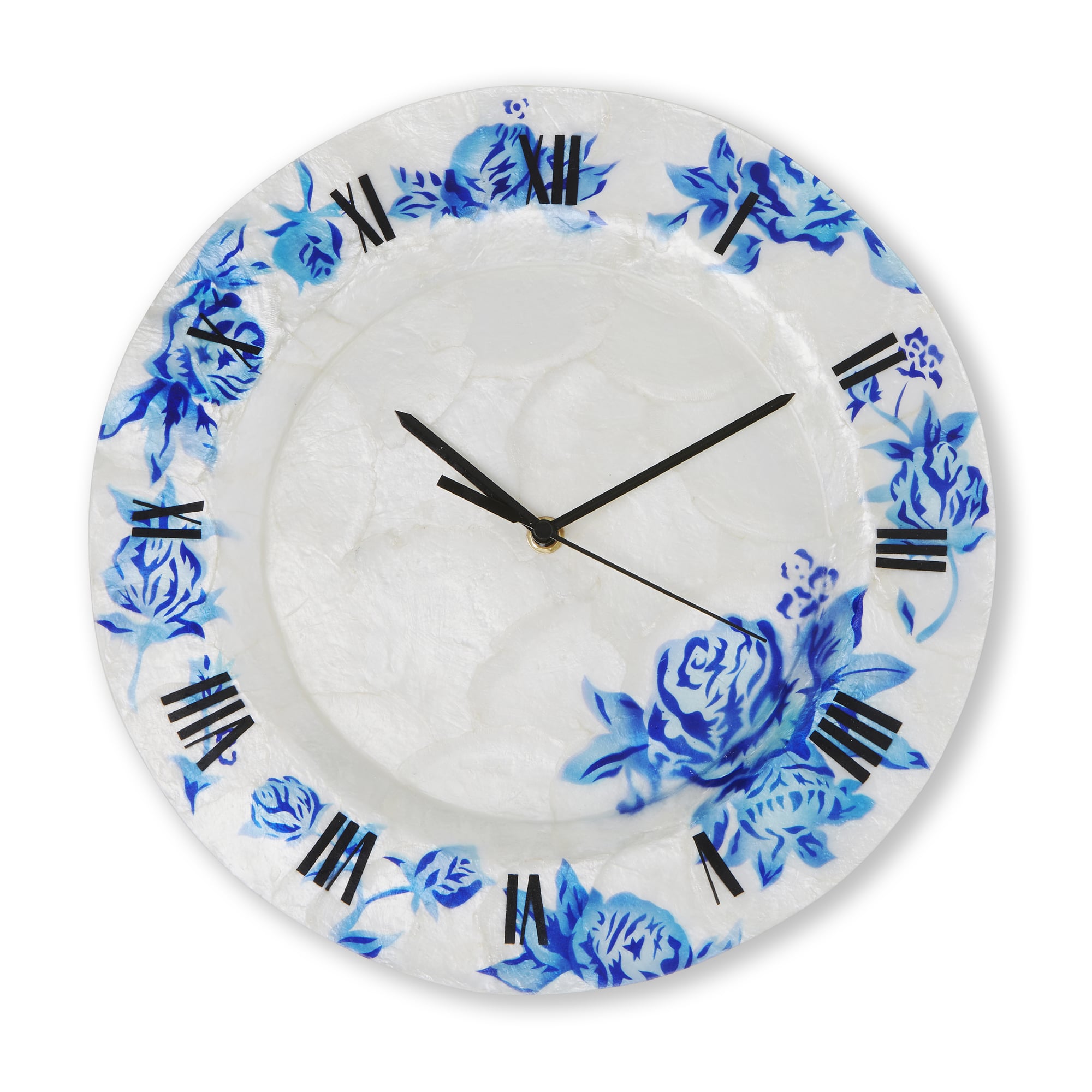 The frame of this clock is made with solid capiz oyster shell, compressed into shape. The artist seals the shells, leaving the natural color of the capiz as the base, pearl color of the clock face. Intricately designed blue roses are hand-painted and purposefully placed along the outer rim. Bold roman numberals are evenly spaced to complement the strong floral design. The combination provides a strong vintage appeal. Capiz is an oyster shell and the primary purpose of the oyster is as a source of food. However, the by-product, the shell, can be used for decoration. The clock is created by compressing capiz shell together and forming it into shape. The final result is a light-weight, plate that feels similar to plastic. Due to it being a natural material, the natural colors of the capiz may come through as tans and browns underneath the hand-painted surface.
The frame of this clock is made with solid capiz oyster shell, compressed into shape. The artist seals the shells, leaving the natural color of the capiz as the base, pearl color of the clock face. Intricately designed blue roses are hand-painted and purposefully placed along the outer rim. Bold roman numberals are evenly spaced to complement the strong floral design. The combination provides a strong vintage appeal. Capiz is an oyster shell and the primary purpose of the oyster is as a source of food. However, the by-product, the shell, can be used for decoration. The clock is created by compressing capiz shell together and forming it into shape. The final result is a light-weight, plate that feels similar to plastic. Due to it being a natural material, the natural colors of the capiz may come through as tans and browns underneath the hand-painted surface. -
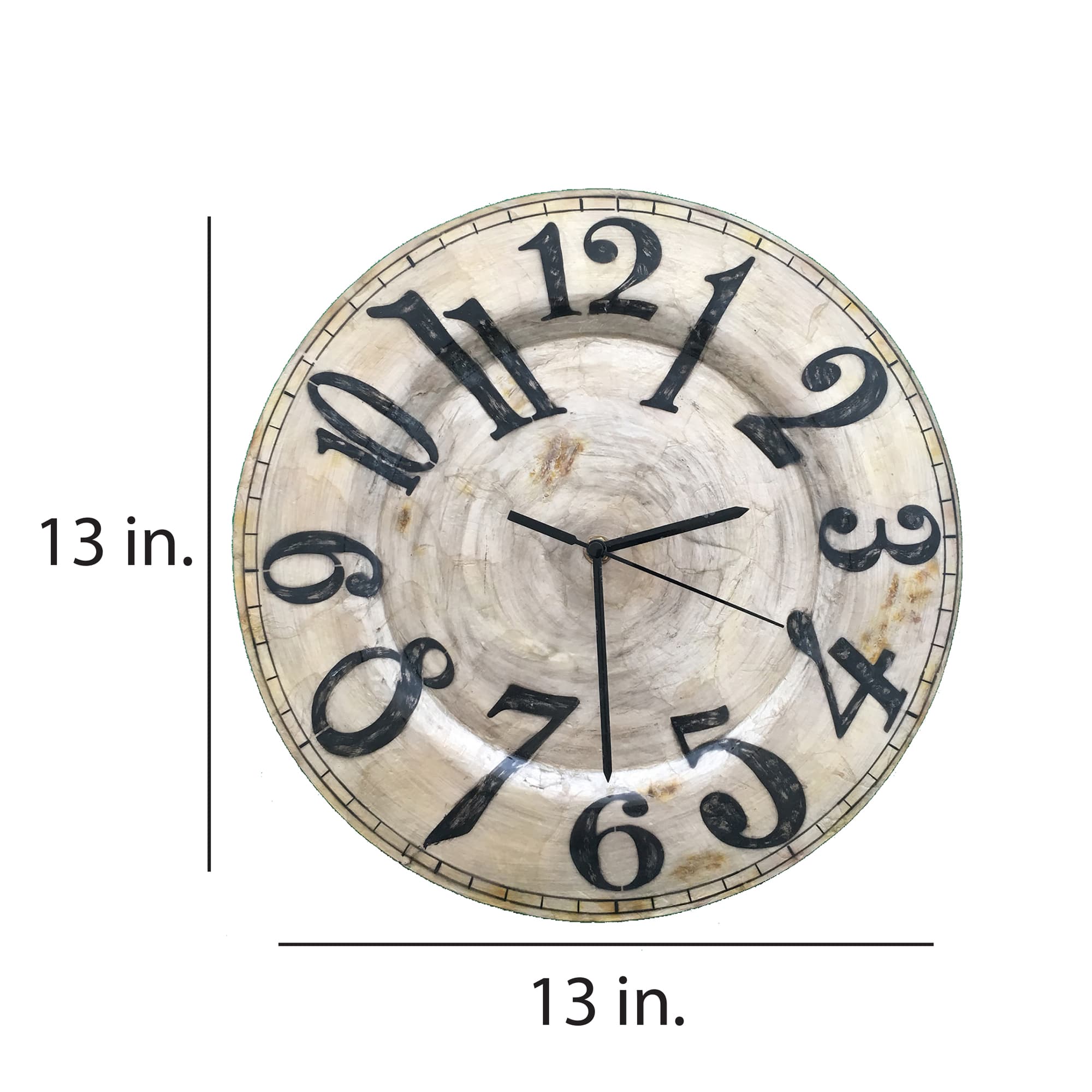
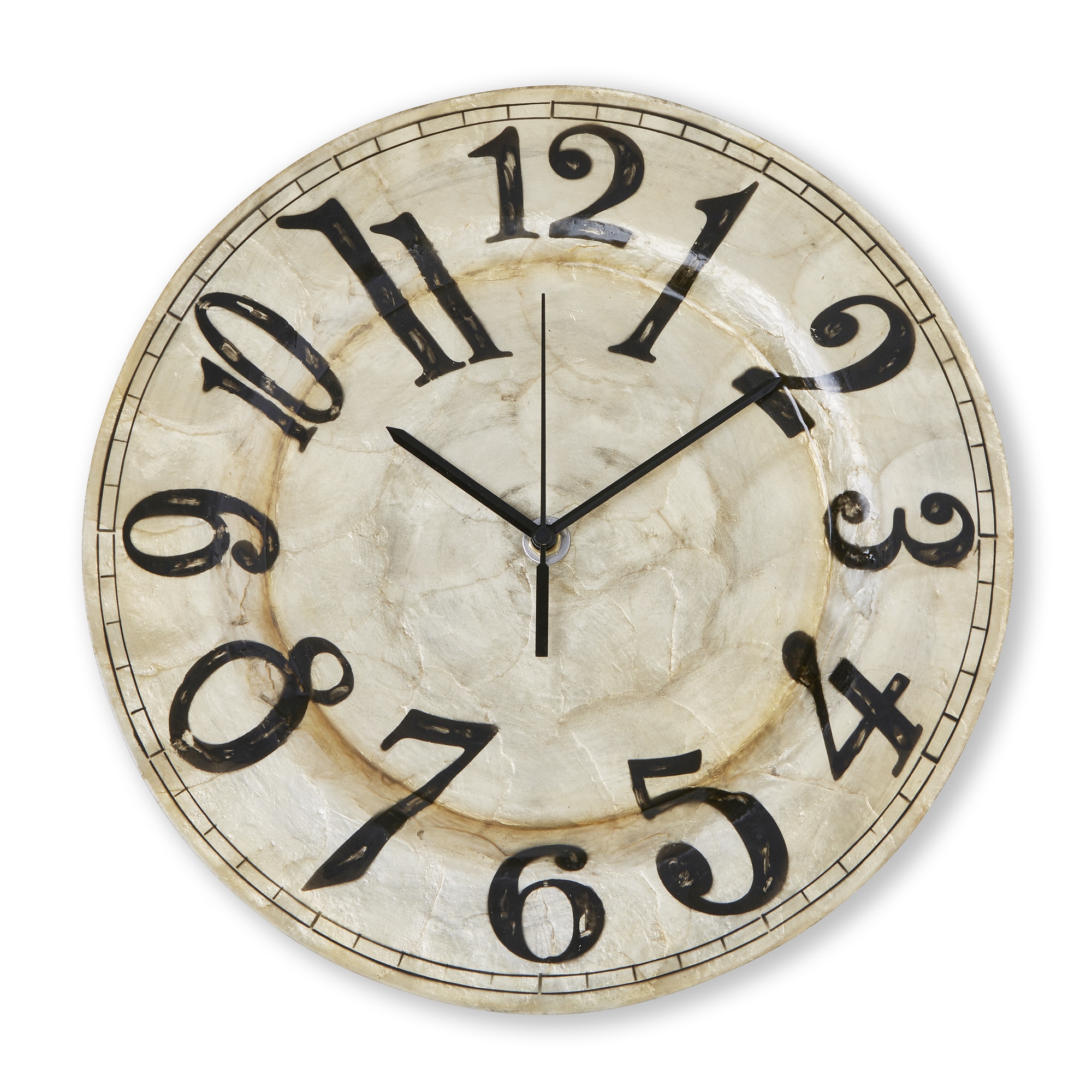 The frame of this clock is made with solid capiz oyster shell, compressed into shape. The face is hand-painted to appear as if it is aged porcelain, promoted by the natual colors of the capiz shell. The look is further accentuated by gentle distressed marks. The black, bold numbers vary in size and stand in strong contrast to the pearl background. The combination of simple color palette and the seasoned feel of the porcelain finish are quintessential hallmarks of the modern farmhouse design genre. Capiz is an oyster shell and the primary purpose of the oyster is as a source of food. However, the by-product, the shell, can be used for decoration. The clock is created by compressing capiz shell together and forming it into shape. The final result is a light-weight, plate that feels similar to plastic. Due to it being a natural material, the natural colors of the capiz may come through as tans and browns underneath the hand-painted surface.
The frame of this clock is made with solid capiz oyster shell, compressed into shape. The face is hand-painted to appear as if it is aged porcelain, promoted by the natual colors of the capiz shell. The look is further accentuated by gentle distressed marks. The black, bold numbers vary in size and stand in strong contrast to the pearl background. The combination of simple color palette and the seasoned feel of the porcelain finish are quintessential hallmarks of the modern farmhouse design genre. Capiz is an oyster shell and the primary purpose of the oyster is as a source of food. However, the by-product, the shell, can be used for decoration. The clock is created by compressing capiz shell together and forming it into shape. The final result is a light-weight, plate that feels similar to plastic. Due to it being a natural material, the natural colors of the capiz may come through as tans and browns underneath the hand-painted surface. -
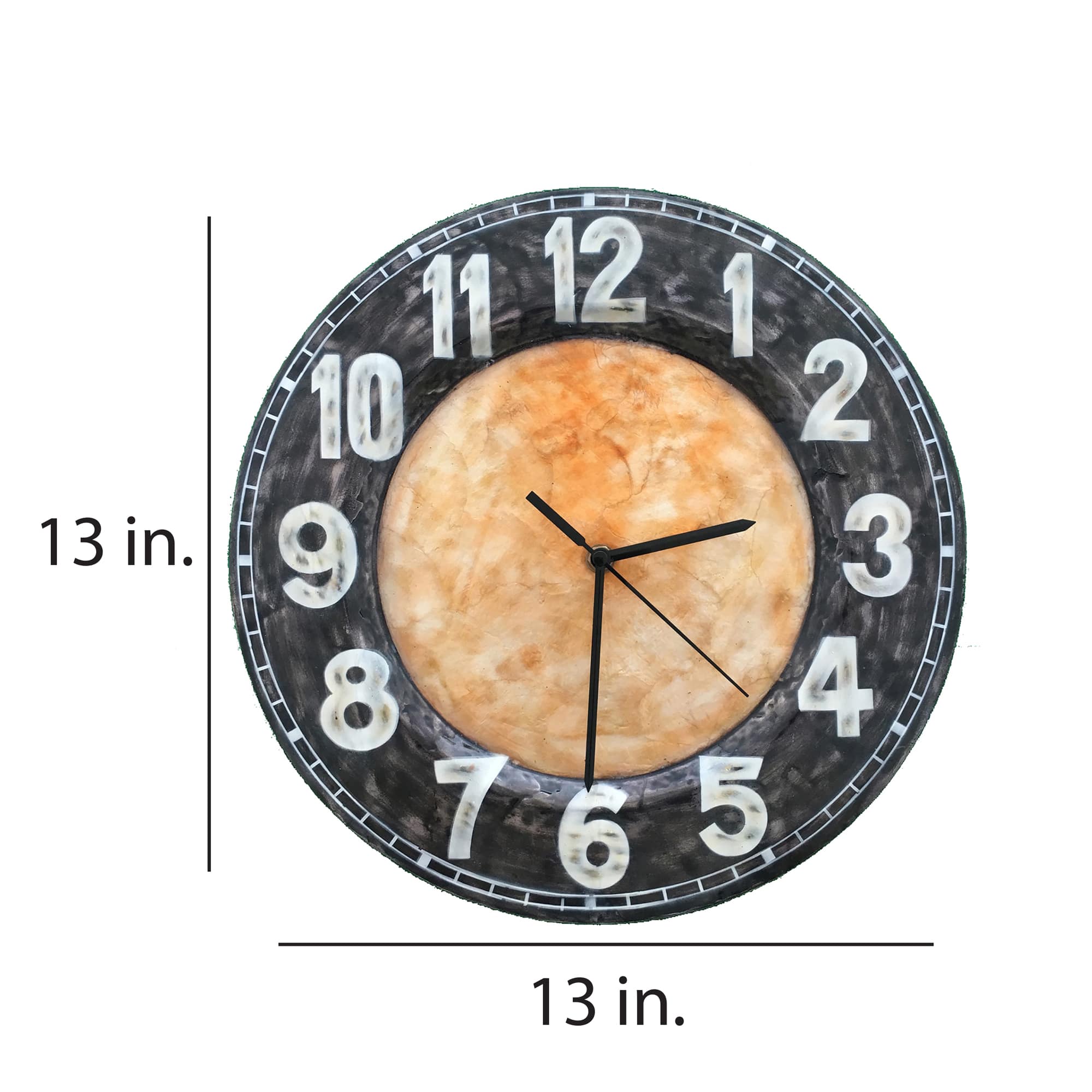
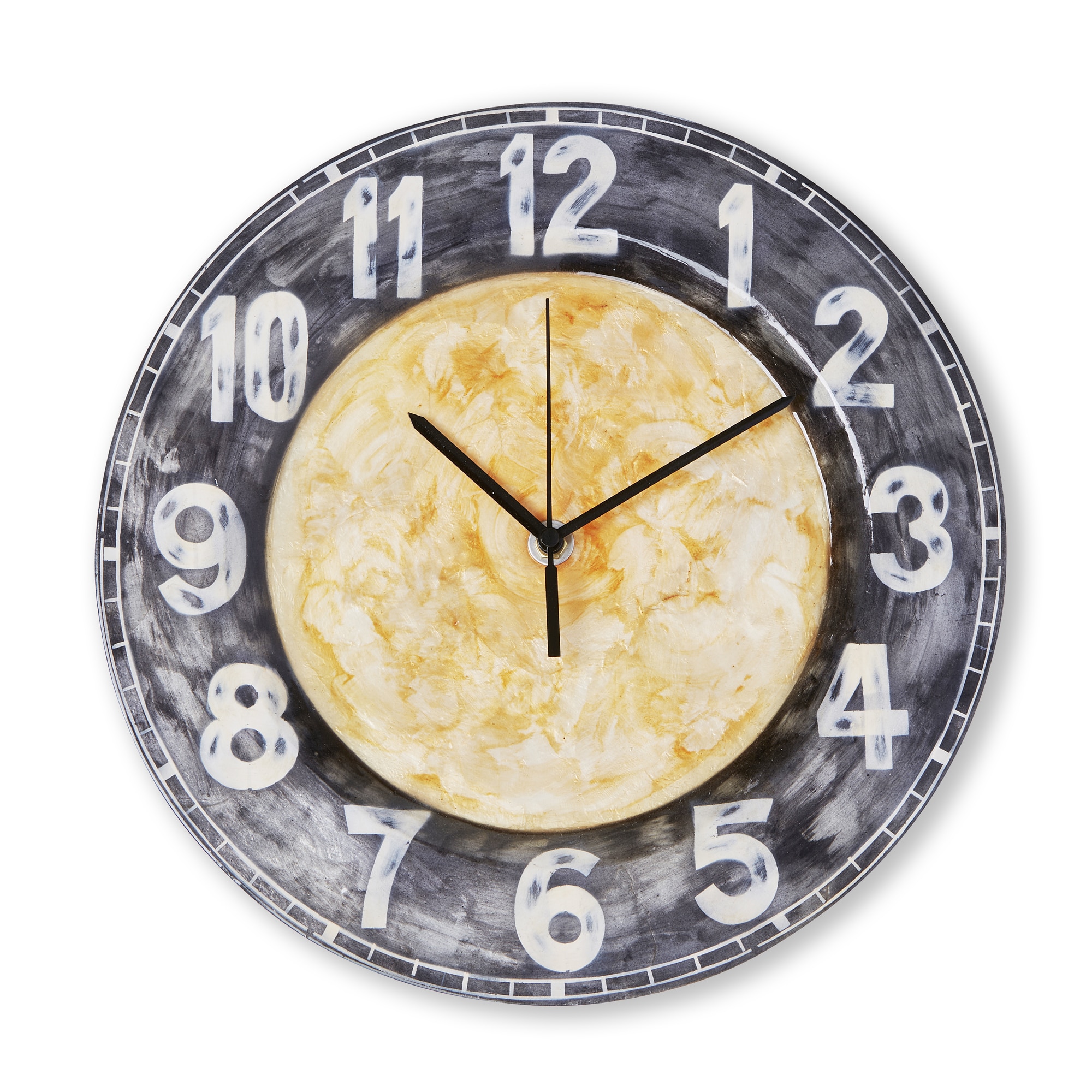 The frame of this clock is made with solid capiz oyster shell, compressed into shape. The texture and lines of the individual shell pieces still come through the hand-painted clock face. The center of the clock is sponge-painted resembling a Mediterranean, terra cotta finish. The darker outer rim and contrasting white, weathered numbers, complete this piece to feel as though it came from the old world. Capiz is an oyster shell and the primary purpose of the oyster is as a source of food. However, the by-product, the shell, can be used for decoration. The clock is created by compressing capiz shell together and forming it into shape. The final result is a light-weight, plate that feels similar to plastic. Due to it being a natural material, the natural colors of the capiz may come through as tans and browns underneath the hand-painted surface.
The frame of this clock is made with solid capiz oyster shell, compressed into shape. The texture and lines of the individual shell pieces still come through the hand-painted clock face. The center of the clock is sponge-painted resembling a Mediterranean, terra cotta finish. The darker outer rim and contrasting white, weathered numbers, complete this piece to feel as though it came from the old world. Capiz is an oyster shell and the primary purpose of the oyster is as a source of food. However, the by-product, the shell, can be used for decoration. The clock is created by compressing capiz shell together and forming it into shape. The final result is a light-weight, plate that feels similar to plastic. Due to it being a natural material, the natural colors of the capiz may come through as tans and browns underneath the hand-painted surface. -
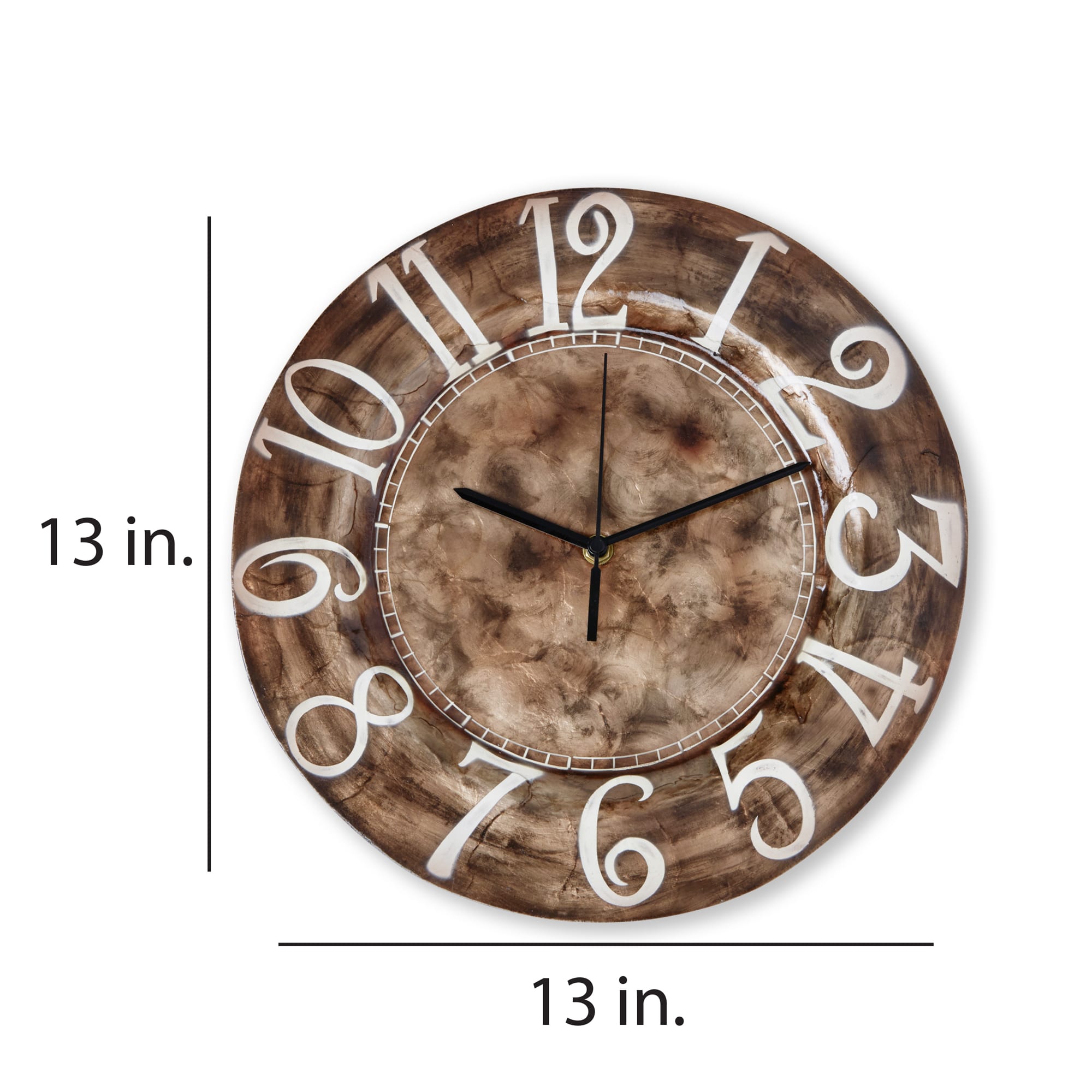
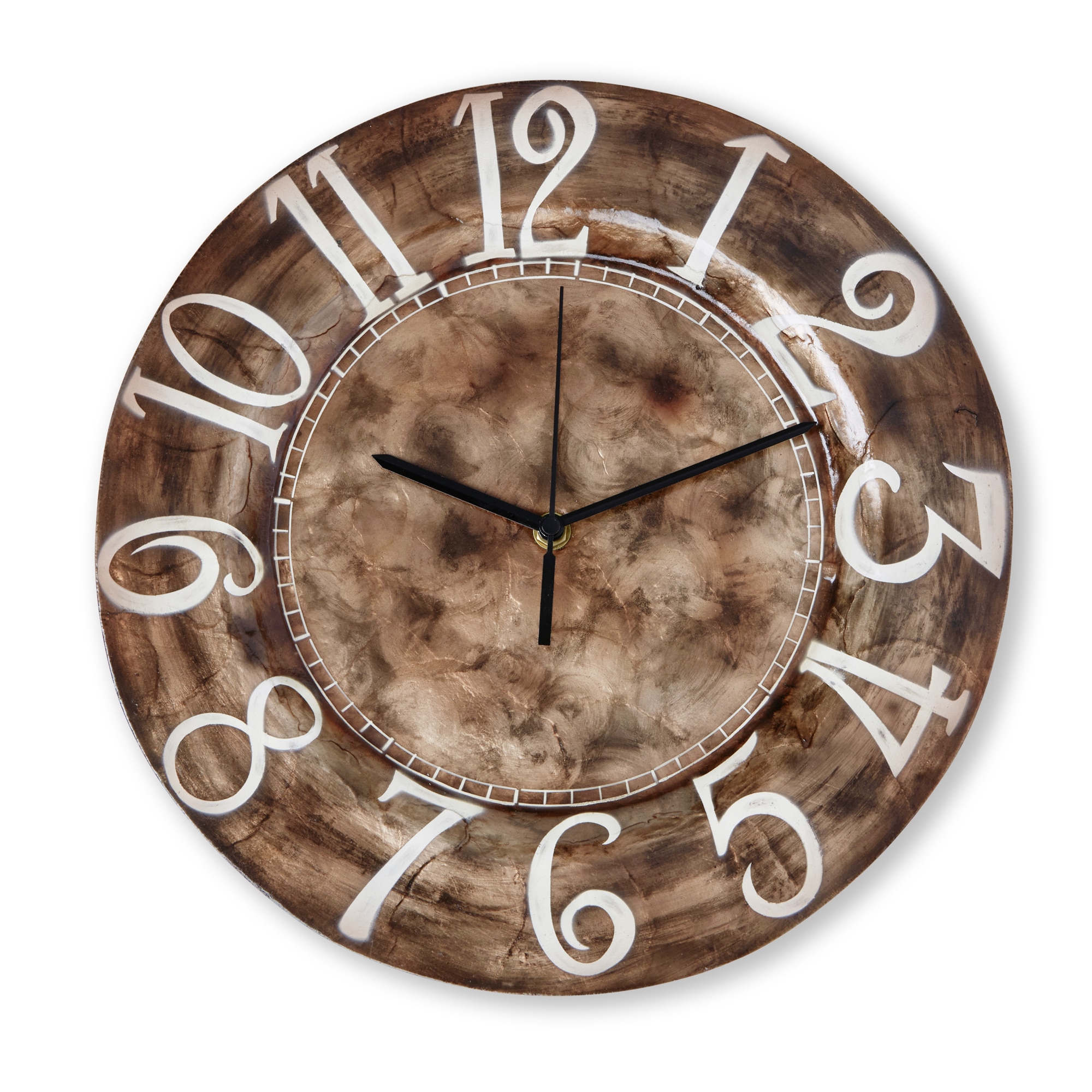 The frame of this clock is made with solid capiz oyster shell, compressed into shape. The texture and lines of the individual shell pieces still come through the broad brush strokes of brown on the background of the clock. The distressed look of the earthy, rich background color giving an aged feel which is complemented by the added detail of the weathered, hand-painted numbers. Capiz is an oyster shell and the primary purpose of the oyster is as a source of food. However, the by-product, the shell, can be used for decoration. The clock is created by compressing capiz shell together and forming it into shape. The final result is a light-weight, plate that feels similar to plastic. Due to it being a natural material, the natural colors of the capiz may come through as tans and browns underneath the hand-painted surface.
The frame of this clock is made with solid capiz oyster shell, compressed into shape. The texture and lines of the individual shell pieces still come through the broad brush strokes of brown on the background of the clock. The distressed look of the earthy, rich background color giving an aged feel which is complemented by the added detail of the weathered, hand-painted numbers. Capiz is an oyster shell and the primary purpose of the oyster is as a source of food. However, the by-product, the shell, can be used for decoration. The clock is created by compressing capiz shell together and forming it into shape. The final result is a light-weight, plate that feels similar to plastic. Due to it being a natural material, the natural colors of the capiz may come through as tans and browns underneath the hand-painted surface. -
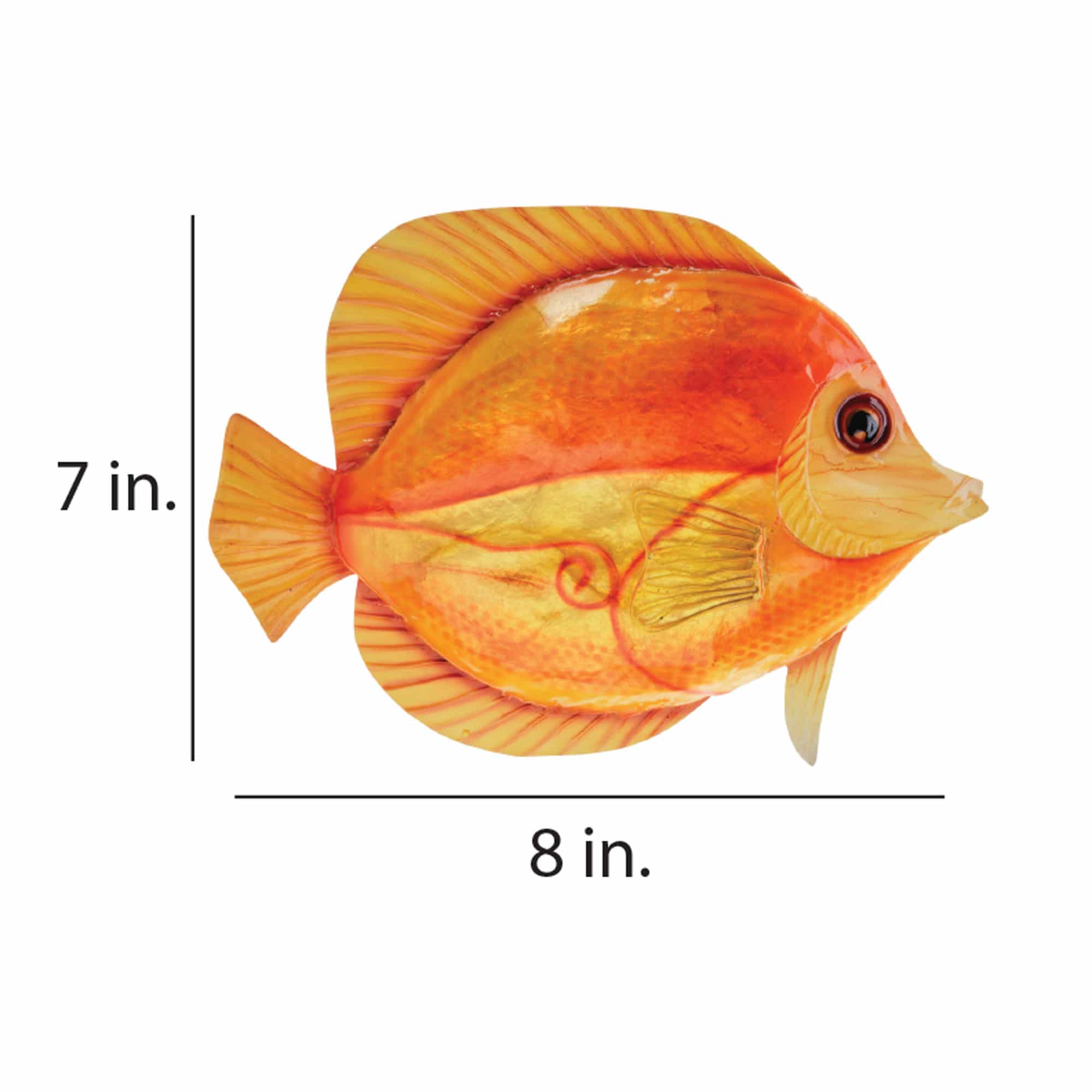
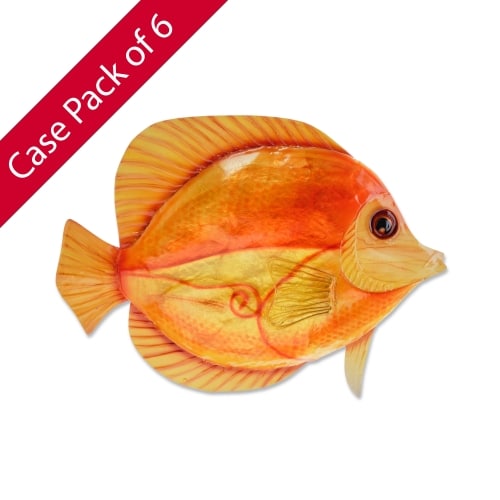 Case of 6 The discus fish is native to the Amazon river basin. These fish are known for their distinctive shape, bright colors, and unique patterns. The artist who painted this fish paid attention to the interacting color patterns. Using capiz shell, he emulated the natural scales of this fish. The basic frame of the wall fish is created using tin, which is powder coated as a black finish. The frame is reinforced using wrought iron wire along the inner edge. Capiz is an oyster shell and the primary purpose of the oyster is as a source of food. However, the by-product, the shell, can be used for decoration. Due to it being a natural material, the natural colors of the capiz can come through as tans and browns underneath the paint.
Case of 6 The discus fish is native to the Amazon river basin. These fish are known for their distinctive shape, bright colors, and unique patterns. The artist who painted this fish paid attention to the interacting color patterns. Using capiz shell, he emulated the natural scales of this fish. The basic frame of the wall fish is created using tin, which is powder coated as a black finish. The frame is reinforced using wrought iron wire along the inner edge. Capiz is an oyster shell and the primary purpose of the oyster is as a source of food. However, the by-product, the shell, can be used for decoration. Due to it being a natural material, the natural colors of the capiz can come through as tans and browns underneath the paint.



